Karl Shuker's Blog, page 4
January 24, 2024
THE HORN SNAKE AND THE HOOP SNAKE - FIERCE CRITTERS OF THE SERPENTINE KIND
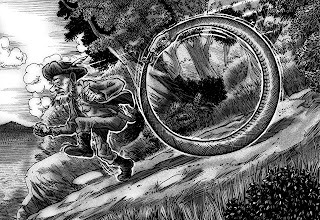 Hoop snake in hot pursuit! (© Richard Svensson)
Hoop snake in hot pursuit! (© Richard Svensson)
Following on from my previous ShukerNatureblog article chronicling what may well be North America's most familiar folkloricFierce Critter of any kind, the truly monstrous hodag (click hereto access my article), I am now documenting the most (in)famous Fierce Crittersof the serpentine kind – namely, the horn snake and the hoop snake.
I must not forget, in these random sketches, myold friend and neighbour, Uncle Davy Lane...Nothing could move him out of aslow, horse-mill gait but snakes, of which "creeturs he was monstrous'fraid." The reader shall soon have abundant evidence of the truth of thisadmission in his numerous and rapid flights from "sarpunts."...Hebecame quite a proverb in the line of big story-telling. True, he had manyobstinate competitors, but he distanced them all farther than he did thenumerous snakes that "run arter him."...
"But at last I ventured to go into the faceuv the Round Peak one day a-huntin.' I were skinnin' my eyes fur old bucks,with my head up, not thinkin' about sarpunts, when, by Zucks! I cum right plumupon one uv the cuiousest snakes I uver seen in all my borned days.
"Fur a spell I were spellbound in three footuv it. There it lay on the side uv a steep presserpis, head big as a sasser,right toards me, eyes red as forked lightnin,' lickin' out his forked tongue,and I could no more move than the Ball Rock on Fisher's Peak. But when I seenthe stinger in his tail, six inches long and sharp as a needle, stickin' outlike a cock's spur, I thought I'd a drapped in my tracks. I'd ruther a harduvry coachwhip [snake] on Round Hill arter me en full chase than to a bin inthat drefful siteation.
"TharI stood, petterfied with relarm — couldn't budge a peg - couldn't even take oldBucksmasher off uv my shoulder to shoot the infarnul thing. Nyther uv us movednor bolted 'ur eyes fur fifteen minits.
"Atlast, as good luck would have it, a rabbit run close by, and the snake turnedits eyes to look what it were, and that broke the charm, and I jumped fortyfoot down the mounting, and dashed behind a big white oak five foot indiamatur. The snake he cotched the eend uv his tail in his mouth, he did, andcome rollin' down the mounting arter me just like a hoop, and jist as I landedbehind the tree he struck t'other side with his stinger, and stuv it up, cleanto his tail, smack in the tree. He were fast.
"Ofall the hissin' and blowin' that uver you hearn sense you seen daylight, ittuck the lead. Ef there'd a bin forty-nine forges all a-blowin' at once, itcouldn't a beat it. He rared and charged, lapped round the tree, spread hismouf and grinned at me orful, puked and spit quarts an' quarts of green pisenat me, an' made the ar stink with his nasty breath.
"Iseen thar were no time to lose; I cotched up old Bucksmasher from whar I'ddashed him down, and tried to shoot the tarnil thing; but he kep' sich a movin'about and sich a splutteration that I couldn't git a bead at his head, for Iknow'd it warn't wuth while to shoot him any whar else. So I kep' my distuncetell he wore hisself out, then I put a ball right between his eyes, and he ginup the ghost.
"Soonas he were dead I happened to look up inter the tree, and what do you think?Why, sir, it were dead as a herrin'; all the leaves was wilted like a fire hadgone through its branches.
"Ileft the old feller with his stinger in the tree, thinkin' it were the bestplace fur him, and moseyed home, 'tarmined not to go out again soon..."
H.E. TaliaFerro ('Skitt') – 'Uncle DavyLane'
Over the years, the annals of zoology havereceived and dutifully logged various reports of some truly remarkablepseudo-serpents, i.e. false snakes once deemed to be genuine species butsubsequently exposed as imaginative folktales, deceiving hoaxes, or monstrousmisidentifications. One of the most intriguing examples is the North Americanhorn snake – not least because it is actually two pseudo-serpents in one!Moreover, as noted above, both of them are derived from the rich FierceCritters folklore of this New World continent's early lumberjacks and otherrural pioneers.
The earliest notable account of the hornsnake appeared in American explorer John Lawson's important work A New Voyage to Carolina (1709; retitledThe History of Carolina in later editions), whose description succinctlyincludes all of the principal characteristics of this singular, highlycontroversial reptile:
Of the Horn Snake, I never saw but two that Iremember. They are like the Rattlesnake in Colour, but rather lighter. Theyhiss exactly like a Goose when anything approaches them. They strike at theirEnemy with their Tail, and kill whatsoever they wound with it, which is armedat the End with a Horny Substance like a Cock's Spur. This is their Weapon. Ihave heard it credibly reported by those who said they were Eye-Witnesses, thata small Locust Tree, about the Thickness of a Man's Arm, being struck by one ofthese Snakes at Ten o'clock in the Morning, then verdant and flourishing, atFour in the Afternoon was dead, and the Leaves dead and withered. Doubtless, beit how it will, they are very venomous. I think the Indians do not pretend tocure their wound.
 Front cover of John Lawson's 1709 book A New Voyage to Carolina (public domain)
Front cover of John Lawson's 1709 book A New Voyage to Carolina (public domain)
In the 1722 self-revised edition of his1705 tome History and Present State of Virginia, Virginia historian andgovernment official Colonel Robert Beverley emphasised the nature of the hornsnake's stinging tail as a formidable weapon:
There is likewise a Horn Snake, so called from aSharp Horn it carries in its Tail, with which it assaults anything that offendsit, with that Force that, as it is said, it will strike its Tail into the ButtEnd of a Musket, from whence it is not able to disengage itself.
The first naturalist to document the hornsnake in detail was Mark Catesby, in the first volume of his major work TheNatural History of Carolina, Florida and the Bahama Islands (1731), summarisingthe descriptions provided previously by Lawson and Beverley, but discountingits tail's deadly nature as outrageous fiction and identifying its species as a'water viper', to which he gave the formal name Vipera aquatica.According to Catesby, the horn snake's tail-sting or spine was merely a blunt,horny, and completely innocuous structure about half an inch long.
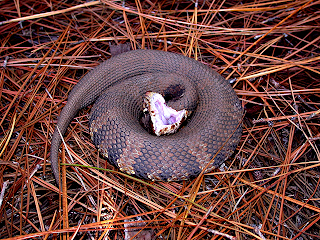 Water moccasin, threat display (public domain)
Water moccasin, threat display (public domain)
Curiously, however, the species that hedubbed Vipera aquatica and labelled as the horn snake is traditionallybelieved to have been the water moccasin Agkistrodon piscivorus - theworld's only species of semi-aquatic viper. Yet although it does possess ashort, thick, blunt-ended tail, the latter does not bear a spine at its tip.Consequently, some modern-day herpetologists dispute that Catesby's so-called'water viper' (and thence his horn snake) was indeed the water moccasin.
Notwithstanding Catesby's scepticismregarding the venomous nature of the horn snake's tail spine, this feature wassteadfastly reiterated in subsequent accounts elsewhere (so too was the claimthat this species was reddish or at least partly reddish in colour). And tocomplicate matters still further, a second, even more fantastic, zoologically-implausiblecharacteristic was soon attributed to this already much-muddled mystery snake –the supposed ability to turn itself into a vertical hoop by grasping its tailin its jaws just like the mythical ouroboros, thereby enabling it to roll alongthe ground at great speed like a living tyre. When carrying out this bizarremode of locomotion, the horn snake thus became known as the hoop snake.
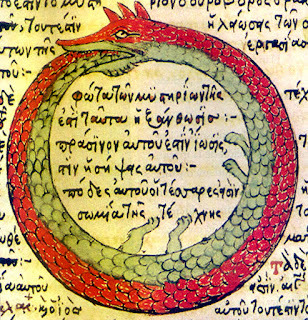 Ouroboros drawing from a late medieval Byzantine Greekalchemical manuscript (public domain)
Ouroboros drawing from a late medieval Byzantine Greekalchemical manuscript (public domain)
An early hoop snake account was penned byAmerican traveller J.F.D. Smyth in 1784, following a stay in western NorthCarolina, and was published in Volume 1 of his multi-tome travelogue Tour inthe United States of America. After describing the by now familiarmorphological characteristics of the horn snake, Smyth added the following veryremarkable behavioural information:
As other serpents crawl upon their bellies, so canthis; but he has another method of moving peculiar to his own species, which healways adopts when he is in eager pursuit of his prey; he throws himself into acircle, running rapidly around, advancing like a hoop, with his tail arisingand pointed forward in the circle, by which he is always in the ready positionof striking.
It is observed that they only make use of thismethod in attacking; for when they fly from their enemy they go upon theirbellies, like other serpents.
From the above circumstance, peculiar tothemselves, they have also derived the appellation of hoop snakes.
The next couple of centuries saw manypublished reports of hoop-rolling horn snakes – hailing from a widegeographical spread, including the Minnesota-Wisconsin border, North Carolina,and British Columbia in Canada - despite their self-evident improbability. Atypical example, which concisely contains all of the intrinsic horn/hoop snakemotifs, is the following account, published on 8 November 1884 by an Australiannewspaper entitled the Maitland Mercury and Hunter River General Advertiserbut documenting an alleged incident that took place in Virginia, USA:
One day last week a littlegirl, whose name slipped the correspondent's usually retentive memory, waschased by a monster hoop snake nearly a mile. Just as it seemed that it wasabout to strike her, she dodged behind a large apple tree. The rapidly whirlingsnake turned to follow and struck the tree with such force as to drive thehorn-spike into the hard wood over two inches. The child was so frightened thatshe sank down, her heart thumping as though it would burst out of her body.
One of her brothers, who hadseen her flying down the hill, went to see what was the matter. When he reachedthe tree it was quaking like an aspen and its leaves and fruit falling to theground in a perfect shower, the prostrate girl being almost buried beneaththem. As soon as he got her restored to consciousness he took a fence rail andkilled the venomous reptile, which was eleven feet two and a half inches inlength and eight inches in circumference. The horn point on the tail was sixand a half inches long, and so deeply imbedded in the hard wood that it couldnot extricate itself. This all happened near South Mountain, Va [Virginia].
With the girl's name convenientlyforgotten, the correspondent responsible for the account not named, and theeminently unlikely nature of the entire incident, the most reasonableassumption is that this incident, like so many others of its kind involvingextraordinary, unbelievable beasts, was a journalistic invention. Yet even today, supposedly serious reportsof hoop-rolling horn snakes are still being documented, thus sittinguncomfortably alongside unequivocally tongue-in-cheek, light-hearted versions,cartoons, and other jokey representations of this classic pseudo-serpent.
 Raymond Ditmars (public domain)
Raymond Ditmars (public domain)
Moreover, it is nothing if not telling thatalthough celebrated American snake expert Raymond Ditmars (1876-1942) placed10,000 dollars in trust at a New York bank to be awarded to the first personwho provided him with conclusive evidence for the reality of the hoop snake,this very substantial prize was never claimed.
But are reports of horn and hoop snakesabsolutely fictional, or could there be at least a kernel of truth at the heartof such ostensibly unfeasible tales? Quite apart from the fact that there aremany fully-attested sightings of snakes grasping their tails in their mouths(albeit while lying on the ground, and therefore yielding horizontal circlesrather than the hoop snake's vertical ones), there are certain fully-recognisedspecies of North American snake that do bear a spiny structure at the tip oftheir tail. So it may be that some of these latter species have helped inspireand shape the legend of the horn snake.
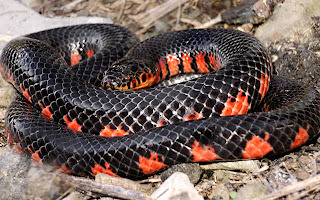 Mud snake (© John Sullivan/Wikipedia –
CC BY-SA 3.0 licence
)
Mud snake (© John Sullivan/Wikipedia –
CC BY-SA 3.0 licence
)
One of the leading candidates for this roleis the mud snake Farancia abacura, a semi-aquatic, non-venomous speciesof colubrid native to the southeastern USA. Up to 6 ft long, black dorsally,black and orange ventrally (with the orange sections extending upwardslaterally, thereby corresponding with certain horn snake accounts referring toreddish-orange sides), this distinctive snake has only a short tail, but itbears a noticeable spine at its tip, which in reality is a greatly-enlargedterminal scale of hard, horny constituency and quite sharp at its tip. Ofcourse, the spine is not venomous, but this species shares a sufficient numberof other characteristics with the legendary horn snake – both the tail spineand the shortness of the tail itself, a tendency to prod prey with its tailspine, plus orange flanks, and a water-frequenting preference – for there to belittle doubt that it has actively influenced traditional, non-scientific beliefin sting-tailed horn snakes.
Certainly, eminent American herpetologistDr Karl P. Schmidt (1890-1957) favoured this identity for the latterpseudo-serpent when documenting the horn/hoop snake saga in an articlepublished in the January/February 1925 issue of the American periodical NaturalHistory. This theory has also been championed much more recently, byanother American herpetologist, Dr J.D. Wilson, in a mud snake articlepublished by the Savannah River Ecology Laboratory in 2006, and not only forthe horn snake specifically but also for its locomotory hoop snake alter ego. Aclosely-related species, the rainbow snake F. erytrogramma, which againis semi-aquatic, non-venomous, native to the southeastern USA, and very similarto the mud snake by virtue of its body colouration, short tail, andreadily-visible tail spine, is actually referred to colloquially as the hoopsnake across much of its geographical range.
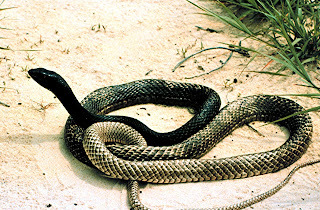 Coachwhip snake (public domain)
Coachwhip snake (public domain)
Yet another North American non-venomouscolubrid that has been implicated with the hoop snake legend is the coachwhipsnake Masticophis flagellum, endemic to the southern USA and alsonorthern Mexico. Up to 6.5 ft long, this species is sometimes reddish-pink incolour, recalling once again descriptions of the horn snake.
Moreover, although it does not possess atail spine, it is a fast-moving, very agile species, and Schmidt, among others,has suggested that the hoop snake component of the horn snake myth may haveoriginated from sightings of species like this one (as well as fellownon-venomous North American colubrid the common black snake Coluberconstrictor – and in particular its most distinctive subspecies, the blueracer C. c . foxii) gliding along at great speed and in an undulatingmanner over the tops of bushes without descending to the ground, thus recallingthe hoop snake's supposed rolling mode of progression.
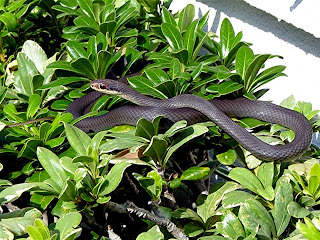 Common black snake (public domain)
Common black snake (public domain)
Interestingly, horn and hoop snaketraditions are not exclusive to North America. Comparable tales have beenrecorded from Australia too. This island continent is home to the highlyvenomous death adders – a genus (Acanthophis) of viper-impersonatingelapids whose several species are all famed for their very conspicuous tailspine.
Central and West Africa are also sources ofsting-tailed horn/hoop snake reports, which in this case appear to have beeninspired by harmless blind burrowing snakes of the genus Typhlops, whichpossess very prominent tail spines. Moreover, Schmidt suggested that slavesbrought to North America from these regions of Africa may have contributed to theNew World horn snake folklore by recalling stories of African burrowing snakesthat subsequently became transferred to America's own equivalent species(though not of the genus Typhlops, as this is confined to Central andSouth America in the New World).
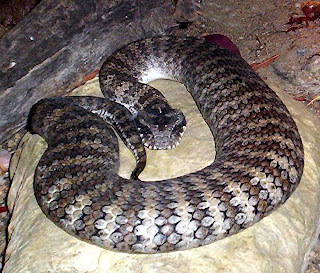 An Australian death adder (public domain)
An Australian death adder (public domain)
Yet regardless of the varied scientificexplanations documented and discussed that discount the horn and hoop snake asbeing wholly fictitious, belief in the reality and lethal nature of thesepseudo-serpents is still deeply ingrained among great swathes of the generalpublic across North America and elsewhere. So much so, in fact, that it seemslikely that their origins will forever remain controversial, and with any investigationsof scientifically-untrained eyewitness reports destined merely to go round andround in circles – just like the hoop snake itself!
Having said that, however, no article onhoop snakes could possibly close without mentioning a truly remarkablesomersaulting snake from the Philippines. Courtesy of a fascinating videoproduced by a longstanding cryptozoological friend, Tony Gerard, there is conclusiveproof of at least one species of snake's extraordinary ability to make dramaticsomersaulting leaps through the air when fleeing a perceived threat.
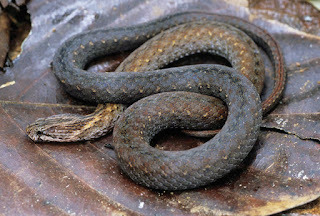 Northern triangle-spotted snake (© R. Brown et al., 2013/Wikipedia –
CC BY 3.0
licence
)
Northern triangle-spotted snake (© R. Brown et al., 2013/Wikipedia –
CC BY 3.0
licence
)The species in question is the northerntriangle-spotted snake Cyclocoruslineatus, a small, non-venomous member of the very diverse, elapid-relatedtaxonomic family Lamprophiidae and endemic to the Philippines. The video(posted here on YouTube by Americanherpetologist/cryptozoologist Chad Arment as StrangeArk on 19 May 2019) showsTony with one of these snakes held briefly under a bowl. When Tony lifts up thebowl and gently prods the snake, it rapidly flees via a series of very dramaticsomersaulting leaps through the air and across the ground, so that it bearsmore than a passing resemblance to the fabled hoop snake.
Indeed, the only reason why I am includingit here, rather than in an article dealing with jumping snakes, is that whereasthe hoop snake was said to turn itself into a hoop by gripping its tail in itsmouth and then rolling along like a vertical hoop or wheel, this Philippinessnake engenders its superficially hoop-like appearance by way of repeatedsomersaulting leaps, without ever grasping its tail in its mouth.
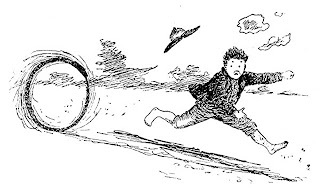 Vintage sketch of a hoop snake by Margaret R. Tryon (public domain)
Vintage sketch of a hoop snake by Margaret R. Tryon (public domain)
Nevertheless, the overall visual effect issimilar enough to make me wonder if other snakes can also accomplish suchsomersaults and, in turn, whether the hoop snake tales originated fromsightings of snakes performing this acrobatic ability, with the tail-in-mouthdetail being subsequently added in elaborated retellings. From such are myths,legends, and folktales born.
ThisShukerNature article is excerpted and adapted from my book SecretSnakes and Serpent Surprises, published by CoachwhipPublications.
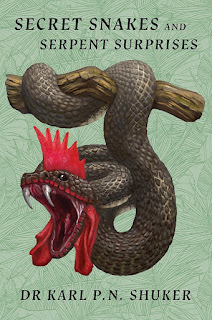
January 20, 2024
THE HIDEOUS HODAG - HISTORY OF A HOAX
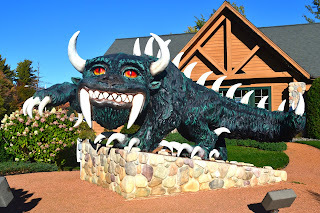 Fibre-glasshodag statue in front of the Rhinelander Area Chamber of Commerce (© GouramiWatcher/Wikipedia –
CC BY-SA 3.0 licence
)
Fibre-glasshodag statue in front of the Rhinelander Area Chamber of Commerce (© GouramiWatcher/Wikipedia –
CC BY-SA 3.0 licence
)
Back in the pioneering days of NorthAmerica, when European settlers were attempting to tame the vast wildernessesfull of unfamiliar creatures in what to them was the new and very strange, evensomewhat frightening continent of North America, rural workers such aslumberjacks and loggers would often spend appreciable periods of time away fromtheir families and homesteads.
Consequently, for company and to keepsafe, they would bond together by gathering around fires in their campsites atnight, deep within the dark, forbidding forests, and while away the hours bytelling tall tales to amuse and play-scare each other, seeing who could spinthe most outlandish, spine-chilling yarns, full of daring feats and terrifyingmonsters – the latter often being inspired by sightings and sounds of what tothem were still very mysterious, potentially dangerous native creatures inhabitingthis immense New World.
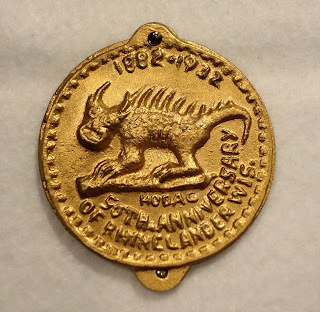 A1932 hodag-depicting commemorative medallion from Rhinelander (public domain)
A1932 hodag-depicting commemorative medallion from Rhinelander (public domain)
These largely made-up monstrositiesbecame known collectively as 'Fierce Critters', and took many different forms.Some were fantastical mammals, birds, reptiles, or amphibians, others werecolossal fishes, creepy-crawlies, or totally bizarre unclassifiables. Today (whichjust so happens to be ShukerNature's 15th anniversary!), I amdocumenting possibly the most famous one of all, Wisconsin's truly horrific,horrible and unequivocally hideous hodag – an allegedly ferocious terror beastthat has long fascinated folklorists and even a few cryptozoologists.
With many Fierce Critters, their originshave been lost in the mists of time, which makes the hodag's history particularlymemorable, in every sense, because this is one whose origin in its modern-dayform is known very specifically, thanks to a certain Eugene Simeon Shepard.
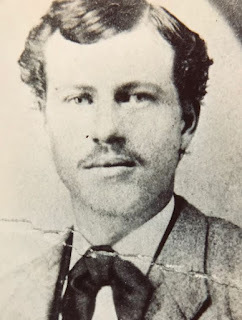 EugeneShepard as a young man (public domain)
EugeneShepard as a young man (public domain)
Born on 22 March 1854 in Old Fort Howard(later renamed Green Bay), Wisconsin, Shepard moved with his family shortlyafterwards to this US state's New London area, where he worked on his father'sfarm for a time after leaving school before moving further afield when hisfather died to work on other, larger farms in wilder, more remote regions. At16, he became an apprentice timber cruiser, in Wisconsin's Northwoods, where helearnt how to assess tracts of forested land for their lumber value.
And it was here, working for yearsalongside the lumberjacks and loggers who did the physical toiling required toconvert the tracts assessed by him into timber, and listening at night to theirhumorous, highly imaginative stories of Fierce Critters, that embryonic visionsof what would become the fearsome hodag in the form by which it is so wellknown today began to stir inside Shepard's singularly inventive mind – a mindthat proved more than capable of outdoing even the lumberjacks and loggers forweaving yarns. In short, Shepard had a serious talent for tall tales, andpractical jokes too, so he decided to put this talent to good, financially-sounduse.
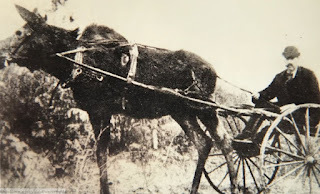 Everthe showman, Eugene Shepard in a cart pulled by a moose (public domain)
Everthe showman, Eugene Shepard in a cart pulled by a moose (public domain)
For although timber cruising had made himrich over the years, Shepard could see that the timber and logging industry,for such a long time a highly profitable one, was now beginning, slowly yetsurely, to die, due in no small way to the wholesale denuding by unceasinglogging of great swathes of land once profusely covered in trees. So if hewanted to stay wealthy, he needed to look elsewhere to make money.
Since 1882, Shepard had lived in theNorthwoods town (now small city) of Rhinelander, within northern Wisconsin'sOneida County, where in addition to timber cruising he had made good moneybuying and selling property, including areas of tree-cleared land for use infarming. Consequently, this is what he saw as his – and Rhinelander's – future,turning the town into a renowned, famous centre for land speculation, propertydevelopment, and farming. But in order for this to succeed, Rhinelander neededto be placed fairly and squarely on the map – the media map, that is. In otherwords, it needed an attraction, one that would serve to draw in from far andwide as many prospective land buyers and farmers interested in settling here aspossible.
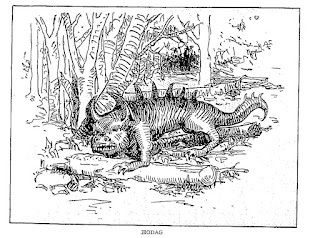 Vintagehodag illustration by Margaret R. Tryon (public domain)
Vintagehodag illustration by Margaret R. Tryon (public domain)
And this was when the enterprisingShepard remembered those folksy fireside lumberjack tales of monsters, inparticular the then only vaguely-defined hodag, and decided to put them togood, practical use – by bringing the hodag to life, literally!
Shepard recalled that the lumberjacks hadclaimed the hodag to be the demonic, vengeful spawn engendered by all the torturedsouls of dead cremated oxen that when alive had been cruelly abused as beastsof burden by these selfsame loggers. Yet apart from stating that like itsbovine progenitors it possessed a fearsome pair of long curved horns, they gavelittle consistent indications of what this malevolent monster actually lookedlike.
 PhineasT. Barnum (public domain)
PhineasT. Barnum (public domain)
Consequently, if he wanted to employ thehodag as his media magnet, Shepard needed to provide it with a well-definedform, which is something that his inordinately creative imagination had littleproblem in conjuring forth. He then needed to transform this newly-renderedmanifestation from a bogey beast of tall tales and yarns into a bona fidephysical, tangible reality – and once again, his entrepreneurial skills soonshowed him the way to achieve this. Not for nothing has Shepard been popularlycompared to that most famous of all 19th-Century American showmenand shysters, the great Phineas T. Barnum himself!
So it was that via a sensational article writtenby himself and published in an October 1893 issue of a Rhinelander newspaperentitled the Near North, Shepardclaimed in his well-honed flair for melodramatic monologues that he and somefellow workers had lately encountered – and killed – an actual hodag inRhinelander's very own forests. He described it as "a terrible brute[that] assumes the strength of an ox, the ferocity of a bear, the cunning of afox and the sagacity of a hindoo [Hindu] snake, and is truly the most fearedanimal the lumbermen come in contact with".
 Artisticrepresentation of the hodag (© Richard Svensson)
Artisticrepresentation of the hodag (© Richard Svensson)
As for its physical appearance: Shepardclaimed that the hodag sported the scaly body of a dragon (and breathed firelike one too), plus the head of a huge bull-horned frog, a terrifying elephantineface that snarled with a fanged grin-like grimace, a row of thick curved spinesrunning along its back, four short but sturdy legs with razor-sharp claws ontheir feet, and a lengthy tail that bore spear-like spines at its tip.
In short, this hodag sounded more than alittle reminiscent of certain non-avian dinosaurs (and was subsequently likenedto such by some chroniclers), in particular certain spine-bearing stegosaurs armedwith thrashing thagomizers, like Kentrosaurus and Huayangosaurus, for instance –overlooking of course its carnivore-consistent fangs, which were conspicuously lackedby these strictly herbivorous prehistoric reptiles!
 Top:Kentrosaurus, life restoration (© ConnorAshbridge/Wikipedia –
CC BY-SA 4.0 licence
); Bottom: Huayangosaurus,life restoration (© Nobu Tamura/Wikipedia –
CC BY 3.0 licence
)
Top:Kentrosaurus, life restoration (© ConnorAshbridge/Wikipedia –
CC BY-SA 4.0 licence
); Bottom: Huayangosaurus,life restoration (© Nobu Tamura/Wikipedia –
CC BY 3.0 licence
)
Speaking of the hodag's meat-eatingproclivities: perhaps the most surprising, offbeat characteristic attributed toit by Shepard was its supposed fondness for devouring an extremely singular,highly specific item of prey – pure-white bulldogs, but only on Sundays! Duringthe remainder of the week, it satiated its hunger pangs by consuming cattle,mud turtles, water snakes, and large freshwater fishes.
Shepard also added somewhat histrionicallythat this revolting hodag stank of "buzzard meat and skunk perfume"(a distinctive characteristic that he would return to in a subsequenthodag-themed escapade – see later), and that despite shooting it with "heavyrifles and large-bore squirt guns loaded with poisonous water", thecreature withstood all of their efforts to dispatch it. In addition, it had alreadytorn apart the hunting dogs that he and his companions had used to corner itafter having encountered this monster in the forests.
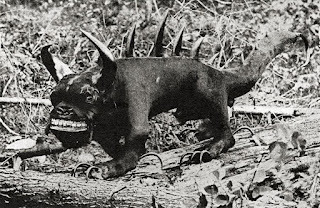 Reconstruction of the hodag based directly upon the specimen in Shepard's 1893 hodag photograph – see below for details re thislatter photo (public domain)
Reconstruction of the hodag based directly upon the specimen in Shepard's 1893 hodag photograph – see below for details re thislatter photo (public domain)
Continuing his febrile fable, Shepardasserted that finally, after hours of fruitless, futile struggle against it, indesperation he and the other men resorted to a very extreme measure – blowingup the hodag using dynamite! Not surprisingly, this certainly worked, reducingit to a mass of charred, unidentifiable remains.
Fortunately (or conveniently, dependingupon your point of view!), however, prior to annihilating their aggressor theyhad been able to photograph it alive – the resulting picture revealing thehodag in all its savage (albeit unexpectedly diminutive) splendour (and despiteits pose being decidedly wooden, in every sense!). This photo was reproducedalongside Shepard's account within his published article, and here it is now inmine:
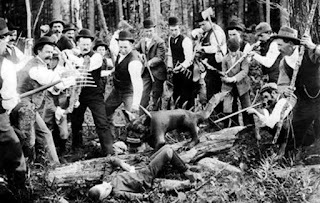 Shepard's1893 hodag photograph (public domain)
Shepard's1893 hodag photograph (public domain)
Although this hair-raising tale certainlyachieved Shepard's aim of attracting some much-needed publicity for, andinterest in, Rhinelander, he was not content to put aside his pranksterpredilection just yet. Three years later, the hodag reappeared in Rhinelander,courtesy once again of Shepard, who went one stage better this second time roundthan he'd previously done. For instead of a mere photograph and some charredcinders, he now chose to present the genuine item – a living, breathing hodag!
The year 1896 saw the very first OneidaCounty Fair, organized to promote Rhinelander as a prospective location forfuture business and farming developments, and just a few days before it openedanother hodag-themed article by Shepard appeared in the Near North newspaper. Once again it related in stirring fashion howhe and some companions had supposedly encountered a hodag in Rhinelander'sneighbouring forests – but this time they didn't kill it. Instead, aftertrapping it inside its den with stones so that it couldn't escape, theysuccessfully chloroformed the creature, enabling them to capture it alive – andnow, at the forthcoming Oneida County Fair, it would be on display, still verymuch living and breathing, for the fair's visitors to see for themselves!
 EugeneShepard's Rhinelander home, with its hodag-holding shed on the right (publicdomain)
EugeneShepard's Rhinelander home, with its hodag-holding shed on the right (publicdomain)
And sure enough, held captive within a shantyyet sturdily-built shed attached to Shepard's own house in Rhinelander, was areal-life hodag – or, to be precise, something that its nervous observers believed to be a real-life hodag.Partially concealed by shadows and a curtain, and held some distance back fromits fee-paying public (who were only permitted to glance upon it through asmall knot-hole), something seemingly resembling Shepard's famous 1893description did indeed lurk, measuring 7.5 ft long, 2.5 ft tall, pitch black incolour and bristly, armed with 12 lengthy spines along its back, moving jerkilyon its short but formidably clawed limbs, and growling. Also, of particularnote, it gave off a putrid stink, just like Shepard had described for it in hisoriginal 1893 article.
Confronted by such a menacing entity, itsvisitors did not stay long enough or approach close enough to obtain a goodview of it, which was just as well, at least as far as Shepard was concerned.For, needless to say, the hodag was a hoax – a large model sculpted from woodenlogs with fine wires attached to make it move. It had been skilfully constructedby Luke Kearney, one of Shepard's friends (who, years later, went on to writethe very informative book The Hodag andOther Tales of the Logging Camps), and was deftly manipulated by Shepard'ssons Claude and Layton, acting like puppeteers (with a hidden dog giving voiceto the supposed hodag's belligerent moans, groans, and growls when prodded by asmall boy). As for its stench, this derived from rank, discarded animal hidesobtained from the local tannery that were used to cover the hodag model'swooden framework.
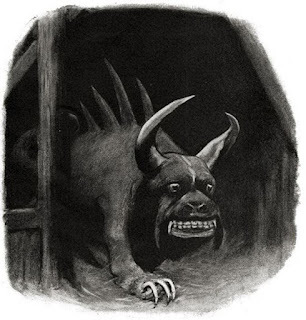 Artisticreconstruction of Shepard's captive hodag of 1896, in Wide World Magazine, May 1915 (public domain)
Artisticreconstruction of Shepard's captive hodag of 1896, in Wide World Magazine, May 1915 (public domain)
Whether Shepard would have ever owned upof his own volition to committing this fraud, or whether he would havecontinued with it, will never be known, because in the event he had no optionbut to confess. For he learned that some scientists from the SmithsonianInstitution were so intrigued by media reports of this astonishing animal thatthey were planning to visit Rhinelander and observe it directly. The game wasdefinitely over, and so was the hodag marionette, which performed no more.
Nevertheless, Shepard's promotion-servingpranks had achieved all that he had hoped for, and more. Rhinelander was indeedon the map now, and the hodag duly entered local folklore on a permanent basis.Yet ironically, Shepard's success actually worked against him on a personallevel, because his hodag hoaxes turned him into an infamous, despised figurelocally, who became shunned both within and even beyond his Rhinelanderhomeland. Tragically, on 26 March 1923 aged 69, Shepard died alone, of kidneyfailure, still estranged from his family and former friends. In modern times,conversely, his reputation has been largely regained and his contributions toRhinelander's thriving success repatriated, due in no small way to the hodag'sfame and lasting legacy in Rhinelander, and Wisconsin in general, for thatmatter.
 EugeneShepard in c.1915 (public domain)
EugeneShepard in c.1915 (public domain)
Indeed, like all the best local legends,down through the decades since Shepard's time the hodag's mythology hascontinued to evolve and expand. Nowadays, for example, several different typesof hodag are recognized.
These include the self-explanatoryshovel-nosed hodag, which also has longer limbs than the standard variety, andthe highly-specialised cave-dwelling hodag, distinguished by its complement ofthree eyes, enabling it to see clearly within its realm's stygian darkness.
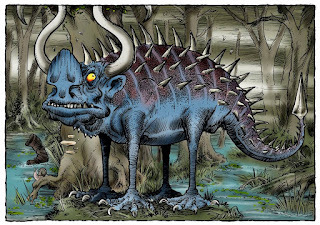
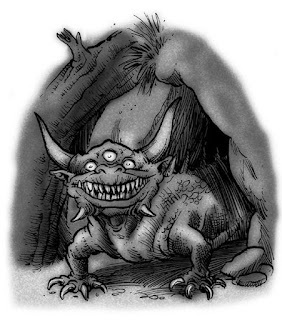 Shovel-nosedhodag (top) and cave hodag (bottom) (© Richard Svensson)
Shovel-nosedhodag (top) and cave hodag (bottom) (© Richard Svensson)
Also, some of the more free-thinkingmembers of today's cryptozoological community actually harbor suspicions thatthe hodag may be more than a fanciful fabrication.
Such speculation posits that there could infact be a real, still-undiscovered animal species evading scientific detectionamid the more remote regions of Wisconsin that inspired Shepard's morphology musingswhen creating his hoax specimens.
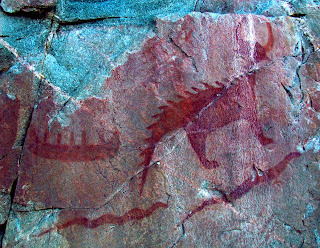 TraditionalNative American pictograph of Mishibeshu at Lake Superior Provincial Park (© DGordon E Robertson/Wikipedia –
CC BY-SA 3.0 licence
)
TraditionalNative American pictograph of Mishibeshu at Lake Superior Provincial Park (© DGordon E Robertson/Wikipedia –
CC BY-SA 3.0 licence
)
It has even been tentatively linked to asuperficially similar-looking mythical entity known as Mishipeshu ('greatlynx'), also dubbed the water panther, and traditionally claimed by a number ofdifferent indigenous peoples of the Northeastern Woodlands and Great Lakes regionto inhabit Lake Superior.
Oral descriptions as well as petroglyphs ofMishipeshu that date back as far as 400 years ago portray a lengthy reptilianwater monster covered with scales but sporting a pair of large cow-like hornson its head, plus a snarling feline face with prominent fangs, four stoutclawed limbs, and a series of long spines running down its back and lengthy tail.Might Shepard have conceivably been inspired by folk-stories of this legendaryaquatic beast when fleshing out his hodag specimens?
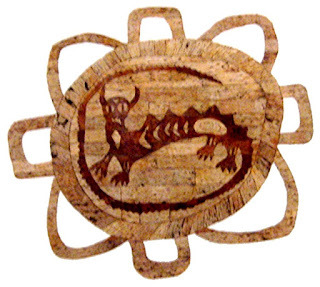 Imageof water panther, from the National Museum of the American Indian, GeorgeGustav Heye Center library (public domain)
Imageof water panther, from the National Museum of the American Indian, GeorgeGustav Heye Center library (public domain)
Notwithstanding any such hypothetical real-lifeor legendary water-dwelling hodag precursors, what is unquestionably a fact isthat today Wisconsin's most exceptional, unexpected representative iscommemorated in all manner of different cultural ways here. Several Rhinelanderorganizations and businesses incorporate the hodag in their formal names, forinstance, plus this city's annual music festival is known officially as theHodag County Festival, its high school embraces the hodag as its officialmascot, and many shops here sell a wide range of hodag souvenirs, includingfriendly hodag cuddly toys.
In autumn 1959, the then-Senator John F.Kennedy was even presented with a miniature hodag figurine when he visitedRhinelander during a political campaign, this unusual gift impressing and delightinghim so much that he placed it on display at his home afterwards for guests totalk about. He also specifically referred to it himself in a subsequent pressinterview (Rhinelander Daily News, 16July 1960).
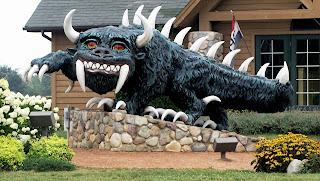 Fibre-glasshodag statue in front of the Rhinelander Area Chamber of Commerce (© redlegsfan21/Wikipedia–
CC BY-SA 2.0 licence
)
Fibre-glasshodag statue in front of the Rhinelander Area Chamber of Commerce (© redlegsfan21/Wikipedia–
CC BY-SA 2.0 licence
)
Most impressive of all, however, are anumber of spectacular hodag statues dotted around this city. Perhaps the mostfamous one is the larger than life-size, bright green, fibre-glass examplecreated by local artist Tracy Goberville that stands proudly in the grounds of theRhinelander Area Chamber of Commerce, with another two on display atRhinelander's Ice Arena (one of which even blows out smoke from its nostrils asits red eyes light up!).
These and other eyecatching replicahodags attract countless tourists visiting Rhinelander every year. Were he hereto see them himself, I feel certain that Eugene Shepard would have approved!
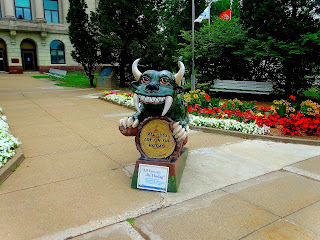 'AllEyes on the Hodag' statue by artist Linda Gilbert-Ferzatta in Rhinelander (© CoreyCoyle/Wikipedia –
CC BY 3.0 licence
)
'AllEyes on the Hodag' statue by artist Linda Gilbert-Ferzatta in Rhinelander (© CoreyCoyle/Wikipedia –
CC BY 3.0 licence
)
Last, but by no means least: from whereis the name 'hodag' derived? It certainly didn't originate with Shepard,because this term existed long before his hoax specimens did. In fact, there isno common consensus as to its etymological origin.
However, the most popular explanation onoffer, and favoured by leading hodag historian Kurt Kortenhof (author of the definitive2006 book Long Live the Hodag: The Lifeand Legacy of Eugene Simeon Shepard) is that 'hodag' derives fromlumberjack slang for one of the implements that they used in their work. Thetwo likeliest possibilities are a type of heavy-duty hoe known technically as agrub hoe, or a type of flat-faced pickaxe known technically as a maddox. So nowwe know…sort of!
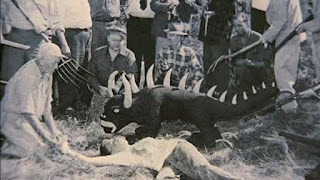
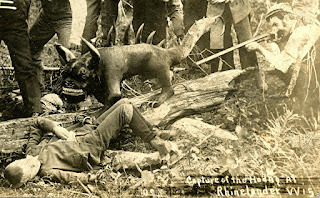 Top:Photograph of a re-creation of Shepard's 1893 hodag capture scene for a 1950 Rhinelanderpageant (public domain); Bottom: Vintage picture postcard presenting Shepard's 1893hodag photograph in close-up (public domain)
Top:Photograph of a re-creation of Shepard's 1893 hodag capture scene for a 1950 Rhinelanderpageant (public domain); Bottom: Vintage picture postcard presenting Shepard's 1893hodag photograph in close-up (public domain)
December 30, 2023
SNEAKING UP ON THE SNAKE CAT
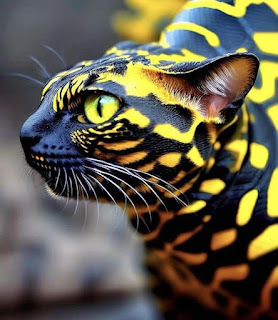 The snake cat photograph (©unknown to me, despite in-depth searches made by me online; AI-generated, viaperson(s) unknown to me – reproduced here on a strictly non-commercial Fair Usebasis for educational/review purposes only)
The snake cat photograph (©unknown to me, despite in-depth searches made by me online; AI-generated, viaperson(s) unknown to me – reproduced here on a strictly non-commercial Fair Usebasis for educational/review purposes only)During earlyMarch 2023, I noticed a certain, very eyecatching photograph doing the roundson social media and inciting all manner of speculation as to the creature that itportrayed. As seen above, it is a close-up head-and-shoulders image of a veryspectacular cat, ornately adorned with vivid black and yellow markings.
According to claimsaccompanying this photo, the animal is a South American snake cat, up to 50 cm (20in) long, weighing as much as 4 kg (9 lb), and allegedly the world's rarest speciesof wild cat, despite the claims also stating that it exists in a number ofdifferent countries, including Colombia, Venezuela, Ecuador, Peru, Bolivia, Guyana,French Guiana, and Suriname.
Within its ostensibly expansive distribution range, thisexotic beast reputedly exists only in the most remote, inaccessible Amazonjungle locations, is poorly studied, and was not even photographed in the wildstate until 2020. Yet the snake cat is supposedly well known to the indigenous locals,who sometimes even rear and tame cubs to use in keeping their homes free of itsvenomous serpentine namesakes and other undesirable creatures.
Looking at this single extraordinary photo – my subsequentinvestigations swiftly revealed that there were no other purported snake catphotos online – I had little doubt that it was a fake, as I had neverencountered any information whatsoever of this mysterious mammal, yet I feltcertain that such a visually-arresting beast would be extensively (andscientifically) documented online and elsewhere if it were indeed real.
Finally, courtesy of a Mexican article, I discovered thetruth. As revealed in a ChihuahuaNoticias news report from 14 March 2023 (click here to access it), the snake cat iswholly fictitious, with its unique photo actually being an AI (ArtificialIntelligence) creation. Quelle surprise!
Looking again at its distinctive markings, I think itlikely that photos of a large and very familiar, wide-ranging species of NorthAmerican amphibian known as the tiger salamander Ambystoma tigrinum, whose bright yellow and black markings readilyrecall the snake cat's, may have played a part in this non-existent entity's photographicgeneration.
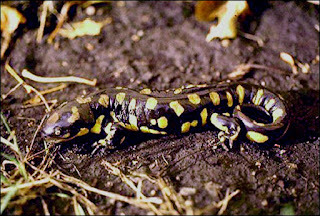 A tiger salamander(public domain)
A tiger salamander(public domain)
December 19, 2023
SOME CRYPTOZOOLOGICAL RIDDLES FROM RUWENZORI
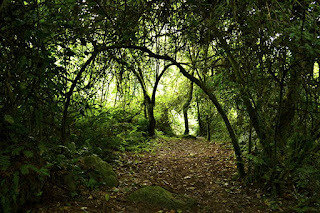 Deepwithin the green secluded forest kingdom of Ruwenzori (© Diego Tirira/Wikipedia –
CC BY-SA 2.0 licence
)
Deepwithin the green secluded forest kingdom of Ruwenzori (© Diego Tirira/Wikipedia –
CC BY-SA 2.0 licence
)Ruwenzori (aka Rwenzori and Rwenjura)constitutes an East African mountain range at the border of the DemocraticRepublic of the Congo (formerly Zaire) and Uganda. Below their peaks' snowycaps and alpine meadows, these mountains are covered in lush tropicalrainforests and are rightly deemed to be a biodiversity hotspot, with manyregions still only sparsely explored scientifically. Not surprisingly,therefore, some interesting potential cryptids have been reported fromRuwenzori, including the three examples presented here.
GOING POTTYABOUT A GIANT POTTO
Some of cryptozoology's least-known mystery beastshave often long been hiding in plain sight, at least in the sense that theyhave been documented in books or articles originally published many years agobut which have never attracted cryptozoological attention. Consequently,whenever possible I try to rectify this sad situation by publicising thesecryptic cryptids once I've learnt about them.
So here is yet another example, kindly brought to myattention on Facebook by longstanding FB friend Richard Hing on 16 August 2023.
In his FB post, Richard wondered if anyone had everheard of a strange creature reportedly existing in Ruwenzori and brieflyreferred to by BBC wildlife film-maker/author Michael Bright in a BBC Wildlife Magazine article fromNovember 1987 concerning the fauna of these infamously impenetrable, inaccessiblemountains.
Michael had been writing about how fascinated by theRuwenzoris and their natural history was Pelham Aldrich-Blake, producer of therenowned TV series The Natural Worldand a longstanding lover of mountain-climbing, and while listing the variouscreatures existing here Michael included the following short but verytantalising paragraph:
Pelham also mentions the occasionalsolitary leopard and a creature that most people consider more mythical thanfact – the 1.5m [5-ft]-long giant Ruwenzori potto, which shares the scientifictwilight with Nessie and the yeti. It is described in the [local native]stories as simply a huge version of the well-known big-eyed primate and issupposed to glower at intruders from the branches of 10m-tall giant heathers.
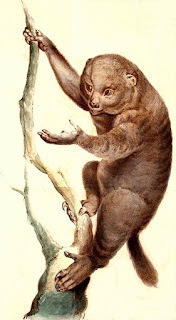 Vintage19th-Century illustration of the common or West African potto Perodicticus potto (public domain)
Vintage19th-Century illustration of the common or West African potto Perodicticus potto (public domain)
Pottos are related to and somewhat resemble the morefamiliar lorises of Asia, especially the slow lorises. For many years, only asingle geographically-widespread potto species, Perodicticus potto, was recognised, inhabiting West Africa, CentralAfrica, and East Africa, but in more recent times this species has been dividedtaxonomically into three separate ones, based on genetic analyses published in2015 indicating that they split from one another in evolutionary terms as longago as the Miocene Epoch (23-5.3 million years ago).
These are now, respectively, the common or WestAfrican potto P. potto, the CentralAfrican potto P. edwarsi, and theEast African potto P. ibeanus. (Thereis also the mysterious false potto Pseudopottomartini, represented only by skeletal remains from two specimens ofuncertain provenance and unknown external appearance, but which may merely beaberrant specimens of P. potto.)
Nevertheless, they are all still united by one verynoticeable shared feature – none of them exceeds around 50 cm [20 in] (includingits short tail) in total length, i.e. only a third the alleged length of theaptly-dubbed giant Ruwenzori potto. Consequently, assuming that the latterreally does exist, and really is 1.5 m (i.e. 150 cm) [5 ft] long, it seemsreasonable to speculate that this exceptionally large variation on the pottotheme does indeed represent a taxonomically discrete form still awaiting scientificrecognition and naming. Incidentally, if anyone has additional informationconcerning it, I would love to receive details!
Nor is this giant potto the only obscurecryptozoological curiosity on record from the Ruwenzoris.
THEMOON BIRDS OF RUWENZORI
Two totally separate reports of very large butstill-unidentified black birds have also been chronicled from these loftypeaks, popularly and poetically dubbed the Mountains of the Moon because theywere traditionally believed to be the real-life identity of the mysterious legendarymountains given this romantic name by ancient Greek and Roman geographers whobelieved that they comprised the long-hidden source of the River Nile.
The first 'moon bird' report, documented by JohnPreston in his Ruwenzoris travelogue TouchingThe Moon, is that of that of the local guide accompanying explorer StephenBagge during his Ruwenzori ascent in 1898.
Bagge reached an altitude of 9,000 ft, but his guideclimbed a little higher, alone, reaching Lake Bujuku, south of Mount Speke.According to this guide, he saw on its shores a number of all-black birds aslarge as sheep, which uttered an alarm call resembling the bellow of a bullwhen he tried to approach them, which scared him away. In 1906, conversely, avery extensive Ruwenzoris expedition led by Italian explorer the Duke ofAbruzzi did not report encountering any such birds there.
However, in his 1957 book Animal Africa, Canadian mountaineer Earl Denman recalled that whileclimbing the Ruwenzoris a few years earlier, he had watched a couple of verylarge unidentifiable black birds diving swiftly and almost vertically throughthe high mountain air. Were these of the same mystery species as those thatBagge's guide had seen, or something different again?
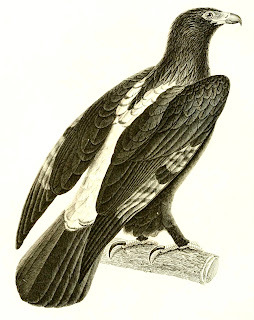 Verreaux's eagle, painted by René Primevère Lesson, 1830 (publicdomain)
Verreaux's eagle, painted by René Primevère Lesson, 1830 (publicdomain)
Cryptozoological author George Eberhart hasspeculated that Denman's birds may have been a pair of Verreaux's eagles Aquila verreauxii – a striking species thatis indeed native to the highlands of East Africa, has predominantly blackplumage, a very impressive wingspan of up to 8 ft, and an extremely dramaticaerial courtship display that features spectacular vertical dives.
Consequently, I think this a plausible identity forDenman's birds, but Bagge's remain far more mystifying.
After all, it seems unlikely that a number of eagleswould all congregate together around the shores of a lake, and utter abull-like sound when approached. To me, such behaviour is much more indicativeof birds such as cranes, herons, storks, or even bustards, but I'm not aware ofany known species that corresponds both morphologically and zoogeographicallywith Bagge's birds.
And so, over a century later, these remain asenigmatic now as they were back in 1896. Once again, any additional info wouldbe very welcome!
 Koribustard Ardeotis kori, Africa'slargest flying bird (only the flightless ostrich is larger), standing 5 ft talland weighing 24-42 lb in the adult male (females are only half this size), butnot native to Ruwenzori (© Haplochromis/Wikipedia –
CC BY-SA 3.0 licence
)
Koribustard Ardeotis kori, Africa'slargest flying bird (only the flightless ostrich is larger), standing 5 ft talland weighing 24-42 lb in the adult male (females are only half this size), butnot native to Ruwenzori (© Haplochromis/Wikipedia –
CC BY-SA 3.0 licence
)
November 28, 2023
DAUNTING DRAGONFLIES OF THE DEMONIC, HORSE-HEADED, AND BROBDINGNAGIAN VARIETIES!
My very own giant dragonfly, chanced upon in a charity shoprecently and now residing in my study (© Dr Karl Shuker)
This ShukerNature blog article of minedocuments an entomological enigma of the cryptozoological kind that has longfascinated, me but which I've never previously blogged about. Namely, the extraordinarypossibility that extra-large dragonflies, veritable giants in some cases, existunrecognised by science in our modern-day world. Consequently, I have gatheredhere an exclusive selection of such reports for your perusal. First of all,however, I'd like to set the scene for them by presenting a couple of comparableexamples plucked from traditional folklore and medieval fancy.
GIANTDRAGONFLIES IN FOLKLORE
On 16 August 2015, I documented here onShukerNature (and subsequently redocumented in expanded form within the firstof my ShukerNature compendium books, ShukerNature Book 1: Antlered Elephants, LocustDragons, and Other Cryptic Blog Beasts, 2019), a fascinating but thoroughly bafflingcenturies-old engraving illustrating a mysterious beast so bizarre inappearance that I dubbed it the locust dragon (click hereto view my original blog article concerning it).
The original source of this specificengraving was a series of prints produced in Antwerp, Belgium, by Flemishengraver Nicolaes de Bruyn (1571-1656) in 1594 that depicted various flyingcreatures.
Although he is best known for his manybiblically-themed engravings and his large engraved landscapes reproducingdesigns and paintings by other artists, de Bruyn produced approximately 400works in total, including a number that featured animals.
 Nicolaes de Bruyn'smystifying engraving from 1594, depicting a wide range of readily-identifiableinsects, plus what can only be described as a truly bizarre 'locust dragon'(public domain)
Nicolaes de Bruyn'smystifying engraving from 1594, depicting a wide range of readily-identifiableinsects, plus what can only be described as a truly bizarre 'locust dragon'(public domain)
The series containing the locust dragon wasentitled Volatilium Varii Generis Effigies ('Pictures of Flying Creaturesof Varied Kinds'), and was first published by Ahasuerus van Londerseel(1572-1635) of Amsterdam.
It was subsequently reissued (with vanLonderseel's name neatly trimmed off!) by Carel Allard in 1663 (or shortlyafter – there are conflicting accounts concerning this detail).
My investigation of what the locust dragonmight conceivably have been attracted a number of replies from readers, postedbeneath my blog article, including one whose subject was entirely new to me andvery intriguing.
Posted on 30 August 2015 by a reader withthe memorable Google username Dracula van Helsing, it mentioned that de Bruyn'sgrotesque locust dragon reminded him of a legend from Cantabria, a region innorthern Spain, concerning certain horse-like demonic dragonflies known asCaballucos (aka Caballitos) del Diablu ('little horses of the devil', despitebeing said to be at least as big as real horses!).
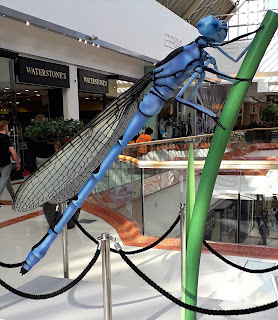 Giant model of a southern damselfly Coenagrion mercuriale, a very eyecatching species of slender-bodieddragonfly native to Britain and several countries across mainland Europe (© DrKarl Shuker)
Giant model of a southern damselfly Coenagrion mercuriale, a very eyecatching species of slender-bodieddragonfly native to Britain and several countries across mainland Europe (© DrKarl Shuker)
Here is Wikipedia's then-current entry onthese very intriguing yet little-known mythical beasts, which has since beenreworded somewhat and expanded (see also below), but was originally derivedfrom Manuel LlanoMerino's book Mitos y Leyendas de Cantabria, published in 2001:
On St John's Eve (June 23), when the peoplemake bonfires to purify their souls, giant dragonflies appear amongst theashes. These dragonflies - the Caballucos - are the souls of sinners, and theycome to release their fury over a year's worth of sins with fire and terrifyingscreams.
The Caballucos del Diablu appear in avariety of colors, each one being the soul of a different sinner. The red horsewas a man who lent money to farmers and then used dirty tricks to steal theirproperties; the white one a miller who stole many thousands of dollars from hismaster; the black one a hermit who played tricks on people; the yellow one acorrupt judge; the blue one an innkeeper; and the orange one a child who abusedhis parents.
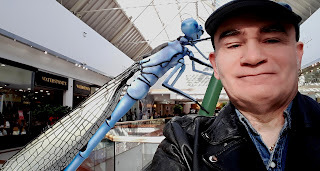 Worryinglyclose to a giant damselfly! (© Dr Karl Shuker)
Worryinglyclose to a giant damselfly! (© Dr Karl Shuker)
And here is this entry's present version, i.e. as oftoday, 28 November 2023:
On St John's Eve (June 23)at night; when the people make bonfires to purify their souls, horses(Percheron purebred) with damselfly wings [damselflies are slender-bodieddragonfly species], black manes and foaming mouths appear amongst the ashes.These stallions – the Caballucos – are the souls of sinners, damned to roamCantabria for eternity, come to release their fury over a year's worth of sins,creating a rumbling explosion with fire accompanied by terrifying screams.
The Caballucos del Diabluappear in a variety of colors, each one being the soul of a different sinner,as legends highlight. The red horse was a man who lent money to farmers andthen used dirty tricks to steal their properties; the white one a miller whostole many thousands of dollars from his master; the black one a hermit whoplayed tricks on people; the yellow one a corrupt judge; the blue one aninnkeeper; and the orange one a child who abused his parents;[1] the green one a lord who possessedmany lands and dishonoured plenty of young women. It is said that the Devilhimself roams the streets riding the red fire-breathing steed, the sturdiestand most powerful who leads the raid, while other demons ride the rest. Theforce in their stomping is such that their horseshoes leave prints on rocks, asif they were freshly ploughed soil. They have gleaming eyes, and blow a strongwind with their nostrils to try impeding lovers from giving corsages to thegirls. The huffs, as cold as winter, are strong enough to make leaves fall fromtrees and bushes. The horses’s food are shamrocks, with they eat tastefully,probably to prevent the seekers who come out at night from finding any. TheCaballucos pounce on everyone they come across, the only things that repelsthem is a bunch of vervain that the person can carry along; the plant has to becollected the day before though, or should be placed next to St John’s fire, towhich they won’t come near. The locals note that sometimes, after becoming wornout by the search, the Caballucos stop to rest and their saliva drips on theground, and turns into gold ingots. Whoever takes them will be made extremelywealthy, but will descent straight to hell after death.
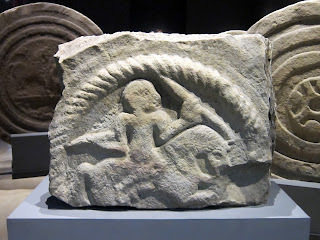 Obverseside of
a stele(carved upright stone) from San Vicente de Toranzo (Cantabria), depicting aridden Cabulluco del Diablu, and displayed at the Museum of Prehistory andArchaeology of Cantabria, Spain (© Valdavia/Wikipedia –
CC BY-SA 3.0 licence
)
Obverseside of
a stele(carved upright stone) from San Vicente de Toranzo (Cantabria), depicting aridden Cabulluco del Diablu, and displayed at the Museum of Prehistory andArchaeology of Cantabria, Spain (© Valdavia/Wikipedia –
CC BY-SA 3.0 licence
)
Yet although giant dragonflies of equine appearance wouldundoubtedly be eyecatching in their own right if such creatures ever existed inreality as opposed to mere mythology, they would not bear any tangibleresemblance to the enigmatic entity upon which my locust dragon investigationshave been focused.
Interestingly, what has been described by some writers asa four-legged, horse-headed dragonfly is also portrayed in the LuttrellPsalter, an English illuminated manuscript dating from c.1325-1340.
However, as can readily be perceived here, theillustration of this incongruous insect bears no resemblance to those of thelocust dragon.
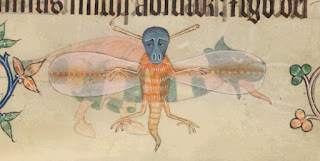 A four-legged, horse-headed dragonflydepicted in the Luttrell Psalter (public domain)
A four-legged, horse-headed dragonflydepicted in the Luttrell Psalter (public domain)
Butthat is still not all as far as controversial giant dragonflies ordragonfly-like mystery beasts of the decidedly daunting kind are concerned.
GIANT DRAGONFLIES IN FACT?
Oneof the fantastical lands visited by physician Dr Lemuel Gulliver in JonathanSwift's famous satirical fantasy novel Gulliver'sTravels (1726) is Brobdingnag, a remote, hitherto-unexplored peninsula ofthe western USA, whose human inhabitants and wildlife are all of giganticproportions.
Accordingly,in real life the adjective 'Brobdingnagian' is often applied to anything ofextraordinarily large size – and could therefore be definitely applied inrelation to certain reports in the cryptozoology archives of supposedly realbut unequivocally oversized dragonflies.
 A painting ofGulliver being inspected by one of the giants of Brobdingnag – note theenormous wasp in the foreground! (public domain)
A painting ofGulliver being inspected by one of the giants of Brobdingnag – note theenormous wasp in the foreground! (public domain)
One ofthese was posted on Lon Strickler's Phantoms and Monsters website, and reads as follows:
Me and my younger brothersaw a huge dragonfly spanning well over a foot and half long in Bolton, Englandin 2002. It must have been over an inch in diameter as well at the centre. Iwould have questioned myself but as it was witnessed by someone else too. I’mpretty sure it wasn’t just me seeing things. Sometimes I think was it an RC [radio/remote-controlled]helicopter? But no way could it move with such swiftness, agility and silenceespecially with 2002 technology. I went to the Manchester museum and checkedwith the insect experts and they said it sounds like you’ve seen something fromthe prehistoric and that no species of dragonfly that exist today are thatlarge. It’s not a giant bird but has anyone ever seen these massivedragonflies? I would love some confirmation some more witnesses across theworld.
Twoyears after this sighting, two comparable ones were posted online in the forumof the Charles Fort Institute's website on the very same day, 25 July 2004. Oneof these was posted by someone I know personally, a well-respected naturalistnamed Oll Lewis. Here is his typically matter-of-fact account of his encounter,which took place in the Vale of Glamorgan, Wales:
I have seen a largedragonfly before, I live near a large country park with 2 huge lakes andextensive reed beds so if there were an ideal place for dragonfly and damselflyspotting, that's it. The largest dragonfly I observed was in Cosmeston LakesCountry Park [and] had a wingspan of at least 1/2 a meter [50 cm] skimming overthe surface of the lake about 3 metres from the bank. It was brownish yellow incolour and apart from its size quite unremarkable.
 A view of Cosmeston LakesNational Park (© Nagezna/Wikipedia –
CC BY-SA 4.0 licence
)
A view of Cosmeston LakesNational Park (© Nagezna/Wikipedia –
CC BY-SA 4.0 licence
)
Isubsequently learned from Oll that he had reported his sighting to auniversity-based entomology professor, who blithely discounted it. Thelongest-bodied dragonfly native to the UK is the golden-ringed dragonfly Cordulegaster boltonii, whose slenderelongate body can reach almost 8.5 cm long in adult females with fully-formedovipositors, and whose wingspan can be as much as 10 cm, The largest UKdragonfly species in terms of wingspan is the emperor dragonfly Anax imperator, whose body averagesaround 8 cm long but its wingspan is up to 10.5 cm. However, these species'impressive dimensions still fall far short of those for the two mystery Britishspecimens described above.
Thesecond Charles Fort Institute forum report was posted by a contributor with theusername laphip. Here it is:
When I was around nineyears old me and my two sisters watched a dragonfly with a body about half ametre long circle around our backyard just above the height of our bungalow (inEdmonton, Alberta, Canada). When we told our mom about it, she just said itmust've been a toy plane shaped like a dragonfly. It looked quite naturally aninsect to me, and it made no sound. Would a dragonfly of that size make or notmake noise in flight? Can toy remote controlled planes be soundless?
Due totheir rapid aerial movements and continual hawking, the size of these insectsis notoriously difficult to gauge accurately, especially by eyewitnesses notfamiliar with them. So overestimation of size would not be difficult. Havingsaid that, the above-noted mentions of remote/radio-controlled aircraft maywell be relevant, especially in light of an unexpected but fascinatingdiscovery that I made recently, and which I'll reveal later here.
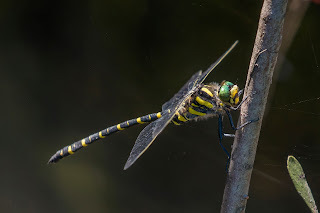 Golden ringed dragonfly Cordulegaster boltonii, male (© CharlesJ Sharp/Wikipedi –
CC BY-SA 4.0 licence
)
Golden ringed dragonfly Cordulegaster boltonii, male (© CharlesJ Sharp/Wikipedi –
CC BY-SA 4.0 licence
)
Anotherreport, forwarded to me in 2001 by Strange Magazine's founding editor,the late Mark Chorvinsky, consists of a report e-mailed to him by correspondentVictor Engel. It reads as follows:
You may be interested in an expedition I plan on this summer. InMay/June 1974 while driving through Mexico, I saw the largest dragonfly I'veever seen. At the time I estimated its wingspan at 14 inches. Since that time,I've not seriously searched for it again, but I have done some research. I'vecontacted dragonfly experts and other insect experts. The general consensus inthe scientific community is that while there used to be dragonflies of thatsize, and, in fact, even larger, they don't, and cannot exist today. The reasoncited for believing they cannot exist today is that the oxygen content of theatmosphere is too low to support the high metabolism required for the dragonflyto catch its prey. Then I got in touch with Dr Gilbert, of the University ofTexas at Austin, who is doing research with imported fire ants and theirparasitic phorid flies. He gave me two well thought-out lists. One was a listof all the reasons why such a dragonfly cannot exist. The other was a list ofreasons why such an insect could possibly exist. Anyway, I'm so convinced atwhat I saw in the 70s that now I'm making a special trip just to find oneagain.
AsEngel correctly mentions, back in ancient prehistoric times there were dragonflies– or, to be precise, dragonfly-resembling insects – that were even bigger thanthe size estimate offered by him for his Mexican mystery specimen. Theseveritable giants are known as griffinflies, in homage to those legendary wingedmonsters the griffins, Originally housed together with the true dragonflies anddamselflies within the taxonomic order Odonata, griffinflies are nowadayshoused in a separate, extinct order, Meganisoptera.
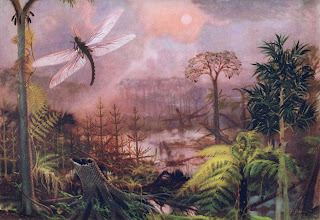 Griffinfly in prehistoricscene, vintage illustration (public domain)
Griffinfly in prehistoricscene, vintage illustration (public domain)
Indeed,fossil remains of Meganeura monyi, a dragonfly that lived approximately300 million years ago during the late Carboniferous Era in what is todayFrance, indicate that it sported a spectacular wingspan of up to 29.5 in.
Moreover,Meganeuropsis permiana, living duringthe early Permian Era, sported a comparable wingspan, thereby making these thelargest insect species, past or present, currently known to science.
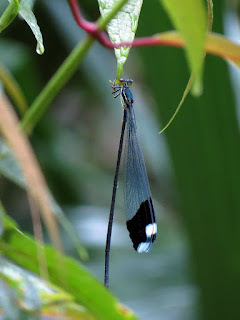 Giant blue damselfly Megalopropus caeruleata (© Katja Schulz/Wikipedia–
CC BY 2.0 licence
)
Giant blue damselfly Megalopropus caeruleata (© Katja Schulz/Wikipedia–
CC BY 2.0 licence
)
Today,conversely, the largest Odonata member is the giant blue damselfly Megalopropuscaeruleata, a damselfly native to Central and South America, whose wingspanmeasures up to 7.52 in, and whose body length is up to 4.72 in. Hence Engel'sspecimen, if accurately estimated, would have a wingspan twice this.
In aJournalnewsOnline article of 15 February 2022, veteran mystery beastinvestigator Brent Swancer recalled being told by a supposed giant dragonflyeyewitness that he and a friend had been hiking together through Florida'sfamous Everglades National Park on a clear day when they saw what seemed atfirst to be a bird, but then they saw that it had four beating wings, not two, andthat its metallic green body was very elongate, measuring over 1 ft long.Moreover, as they watched, the creature came close enough for them to discernthe multi-faceted form of its eyes, as characteristically exhibited by thecompound eyes of adult insects, hovering in front of them for a moment beforeit swooped off again, its flight entirely silent throughout.
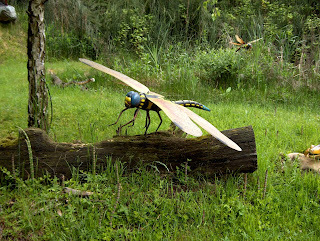 Scale model of a griffinfly(© GermanOle/Wikipedia –
CC BY-SA 3.0 licence
)
Scale model of a griffinfly(© GermanOle/Wikipedia –
CC BY-SA 3.0 licence
)
It iswell known that the tracheal-based respiratory system of insects, whoseinternal network of minute cell-penetrating, air-transporting tubes is onlycapable of transporting oxygen over tiny distances, precludes these creaturesfrom attaining the gargantuan sizes beloved of sci-fi movie makers, and even fromthose attained by the long-demised griffinflies, as the oxygen content of theatmosphere that existed way back in their time was much greater than it istoday.
Bearingthis in mind, therefore, what on earth – or anywhere else, for that matter! –can we say about the absolutely ginormous dragonfly lookalikes that a readerwith the username PoeticsOfBigfoot posting to the cryptozoology websiteCryptomundo on 28 June 2013 claimed to have observed over a lengthy period oneevening in, fittingly, Texas?
Giant insects are more common in the Southwest than peoplerealize. I saw huge dragonfly-like insects around sundown near Terlingua TXonce. I estimate they were eight feet long or so, with about the same wingspan.They had some sort of long whip-like appendage at their posterior end, a littlelonger than their bodies, that arced upward. I saw three of them over atwo-hour time span.
 Confronted bya monster dragonfly sculpture of truly monstrous proportions in Wroclaw, Poland(© PiotrPrzybyszewski/Wikipedia –
CC BY 3.0 licence
)
Confronted bya monster dragonfly sculpture of truly monstrous proportions in Wroclaw, Poland(© PiotrPrzybyszewski/Wikipedia –
CC BY 3.0 licence
)
Maledragonflies do possess a pair of claspers at the tip of their most posteriorabdominal segment, and females bear a single circus there, but these arenowhere near as long as the insects' bodies. So too did griffinflies, but withthe same proviso. Moreover, for the respiratory reasons mentioned above, an8-ft-long insect living today, most especially one as metabolically active as afast-flying dragonfly, would be a physiological impossibility.
Andeven if it wasn't, such a spectacular, readily visible entity native to NorthAmerica would assuredly have been discovered, described, and fully documentedby science long ago. So although dragonflies are predatory, I wouldn't worryunduly about being dive-bombed any time soon by the terrorflies of Terlingua!
Unless,of course, this titanic trio had winged their way to Texas from Brobdingnag'ssecluded peninsula??? Gulliver's remarkable travels and his numeroushair-raising experiences during them had so transformed his personality thatafter he finally returned safely home, he became a recluse. After encounteringmonsters like these, can you blame him??
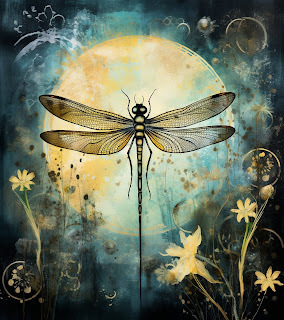 Fictional giantdragonfly with long whip-like posterior process like the three 8-ft-long Texasspecimens (public domain)
Fictional giantdragonfly with long whip-like posterior process like the three 8-ft-long Texasspecimens (public domain)
Seriously,however, I have recently learned to my surprise but delight that giantradio-controlled dragonfly models not only exist but be readily purchased oncertain websites – so might these fascinating fliers explain such sightings, includinglaphip's noted earlier here, especially if they were spied in dim lightconditions? Then again, eyewitnesses of such creatures have often claimed thattheir flight was totally silent, thus suggesting that they weren't remote-controlledaircraft or drones after all.
In short, unless we dismiss all suchreports as involving hoaxes, misidentifications of non-insect aerial creatures,or exaggerated size estimates of bona fide dragonflies, the mystery of thesegiant flying insects remains very much up in the air – as indeed do they!
Formy expanded coverage of the locust dragon, be sure to check out ShukerNatureBook 1, whose front cover sports a gorgeousfull-colour painting by longstanding friend and superb artist Anthony Walls, inwhich he portrays me with said locust dragon perching contentedly on myshoulder:
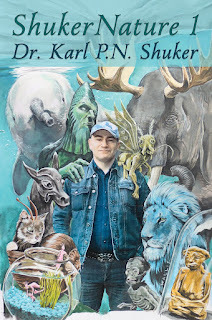
October 17, 2023
'SHUKERNATURE BOOK 3: CRYSTAL PALACE DINOSAURS, JUNGLE WALRUSES, AND OTHER BELATED BLOG BEASTS' - MY BRAND-NEW, 34TH BOOK IS NOW PUBLISHED!
 Thefull wraparound cover of my brand-new, 34th book
ShukerNatureBook 3: Crystal Palace Dinosaurs, Jungle Walruses, and Other Belated BlogBeasts
(© Dr KarlShuker/Coachwhip Publishing)
Thefull wraparound cover of my brand-new, 34th book
ShukerNatureBook 3: Crystal Palace Dinosaurs, Jungle Walruses, and Other Belated BlogBeasts
(© Dr KarlShuker/Coachwhip Publishing)I'm very happy to announce today that my 34thbook is now officially published, and as you can discern from its title – ShukerNature Book 3: Crystal Palace Dinosaurs, Jungle Walruses,and Other Belated Blog Beasts – it'sa third compendium of my most significant ShukerNature blog posts, expanded andupdated wherever possible, packed with colour and b/w illustrations, and 404 pageslong.
If youhave purchased either or both of my previous two (as I'm sure you have!!), youwill know that ShukerNatureBook 1 was devoted to creatures I'd blogged about thatI referred to in its subtitle as cryptic. That is, not merely cryptozoologicalin most cases but also (indeed, especially) little-known, esoteric examples - fromthe likes of locust dragons, king hares, giant oil-drinking cathedral spiders, andLinnaeus's hellish fury worm, to medieval snail-cats, glowing lightbulblizards, tizheruks, tsmoks, and many more offerings from the most obscurerealms of unnatural history.
For ShukerNature Book 2, I concentratedupon creatures I'd blogged about that I referred to in its subtitle asmonstrous. That is, straddling the often ill-defined borders between themythological and the mundane, fantasy and fact, reverie and reality - such asliving gorgons, bottled homunculi, fossil griffins, Lewis Carroll's mockturtle, Harry Potter's ambiguous amblypygid, and Doctor Dolittle'spushmi-pullyu, the Big Grey Man of Ben MacDhui, Wisconsin's giant grasshoppers,South America's photographed but non-existent 'ape', and all manner of otherfascinating if macabre curiosities and caprices from the shadowy hinterlands ofdarkest zoology.
 My first two ShukerNaturecompilation books (© Dr Karl Shuker/Coachwhip Publications)
My first two ShukerNaturecompilation books (© Dr Karl Shuker/Coachwhip Publications)
Forthis present, third ShukerNaturebook, however, I elected to veer off into a very different direction whenselecting its contents as drawn from my blog. I've been a professionalcryptozoological researcher and writer for almost 40 years now, so, as you canimagine, I've covered a vast array of subjects during that lengthy period of time.Yet however many I do document, there are always countless others jostling forposition on the literary sidelines, impatiently agitating to secure their placein a future book or article of mine. Of these, there are a number that I havefully intended to blog about for many years, but for a multitude of differentreasons I have somehow never got around to doing so in spite of just how muchthey have always fascinated me. Equally, there are subjects that my manyreaders down through the years have persistently asked me to blog about butwhich again, inexplicably, I've never actually done so.
Duringthe lengthy, enforced periods of social lockdown necessitated by the Covid-19pandemic, however, I made a determined effort to rectify my previousprocrastination concerning these undeservedly delayed subjects, by researchingand blogging about as many of them as possible. Having now done so with asizeable selection, it is these, therefore, that constitute the theme of thisthird ShukerNature book – which inturn safeguards them from the uncertainties of ongoing online existence bypreserving them for all time in print.
Theyinclude such long-awaited topics as the awe-inspiring Crystal Palace dinosaur statuesthat I visited and photographed over a decade ago but never wrote up afterwards(but which are now the subject of my book's spectacular wraparound cover – the veryfirst such cover that has ever graced any of my books), my personal (andundoubtedly controversial, iconoclastic, heterodox) views regarding the(in)famous Surgeon's Photograph reputedly depicting an unknown object in LochNess, the huge but mysterious animal head discovered in an ancient Egyptianboat, and the muddle of misidentification surrounding Lake Dakataua's aquaticmigo.
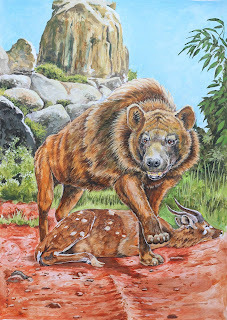 Longstanding friend and awesome artist Anthony Wallis'sstunning portrait of the Nandi bear that he prepared exclusively for inclusion inthis latest book of mine – thanks Ant! (© Anthony Wallis)
Longstanding friend and awesome artist Anthony Wallis'sstunning portrait of the Nandi bear that he prepared exclusively for inclusion inthis latest book of mine – thanks Ant! (© Anthony Wallis)
Plus theNandi bear specimen that was actually examined by two of the world's foremostscientists before it mysteriously vanished, the officially-impossible elephanthybrid whose existence proved all the experts wrong, the wry comedy ofzoological errors enshrouding the huge but hysterical imperial flea, as well asan eclectic assemblage of jungle walruses, flying monkeys, hairless hyaenas, Koch'smonstrous Missourium and horrid Hydarchos, Beebe's black-and-white mysterymanta ray, the giant lizards of Papua, a tenacious tomb-shattering pterodactyl,and lots more too.
Somany of these curious, charismatic subjects have been a long time coming, Ifreely confess – but now that they arefinally here for you to read about and ponder over, I hope very much that, aswith all the best things in life, you'll consider them well worth the wait. Moredetails concerning my book can be found on its dedicated page here,in my official website.
As always, my new book can be ordered directlythrough Amazon.com, Amazon.co.uk, and other online bookstores,or ordered via your local physical bookstore anywhere.
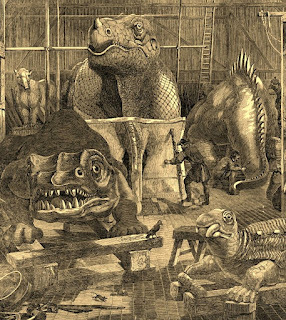 Vintageengraving of 19th-Century sculptor Benjamin Waterhouse Hawkins's CrystalPalace studio in 1853, containing some of his completed prehistoric animal statues(public domain)
Vintageengraving of 19th-Century sculptor Benjamin Waterhouse Hawkins's CrystalPalace studio in 1853, containing some of his completed prehistoric animal statues(public domain)
October 13, 2023
LOUISIANA'S GIANT SPIDERS - AN INDEPENDENT EYEWITNESS AT LAST!
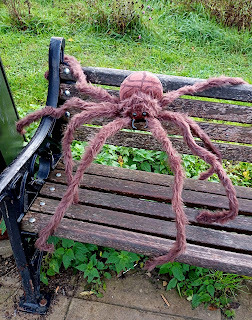 Agiant spider model owned by longstanding friend and fellow cryptozoology enthusiastMike Playfair (© Michael Playfair)
Agiant spider model owned by longstanding friend and fellow cryptozoology enthusiastMike Playfair (© Michael Playfair)In a trio of detailed ShukerNature blogarticles posted by me during summer 2020 and spring 2021 (click here, here, and here to read them), I documented thefascinating if exceedingly startling series of claims that had been emailed tome by a United States soldier concerning the supposed presence of enormousspiders seen by him and others on several occasions during 2005 and 2007 at US armytraining areas at Fort Polk, Louisiana's Joint Readiness Training Center, wherefor several weeks back then he'd been stationed for complex field training.
As I discussed in my accounts, however, thefundamental physiological problems of such sizeable spiders even being capable of existing, let alone actually doing so, would seem sufficient reasonsin themselves for discounting these claims out of hand. Yet the extent ofdetail provided by this self-alleged eyewitness (I do have a name for him onfile but in deference to his request to remain publicly anonymous I have neverrevealed it) is such that I felt it warranted published coverage, if only tosee if it elicited any independent, corroborating reports from anyone else.
Now, finally, after more than two years,it has done so, and not from some stranger either, but instead from alongstanding friend on Facebook – namely, veteran monster/mystery beast fanRich Janusz from Connecticut.
 Myown giant spider model (© Dr Karl Shuker)
Myown giant spider model (© Dr Karl Shuker)
On 10 July this year, Rich sent me threeprivate messages in swift succession on Facebook, and gave me his fullpermission to document them in a future ShukerNature article – thanks Rich! Dueto pressing work commitments, however, I wasn't able to do so straight away,but I am doing so now, having combined his three messages together into asingle continuous communication – so here it is:
I have read over the yearsyour reports of giant spiders in the Fort Polk area. I will give you my wife'sbrother's account.
My wife's brother is an MPin the CT NG. Some years ago, he went to Fort Polk for training. He wastraining on the use of night vision goggles. They heard a rustling noise, andhe swears that himself and his friend saw a spider at least as big as a trashcan cover crawl across the trail that they were watching. He is not a bs artistby any means. He has told me this story several times and I believe him.
Sorry that I can't be morespecific about dates, call it 2011 or 2012.
At first her brotherlaughed and said that they were campfire stories. Later he said we'll talklater, [and] a few weeks later he told me the story. Since then he has told itamong family and friends. Plus, what was his reaction to the incident? Him andhis friend debated going back the way they came, and decided to continue, butvery cautiously at first, and then they practically ran through the exercise.
As indeed I would have done had Iencountered at close range at night a spider the size of a dustbin lid (my UK-Englishtranslation of trash can cover!).
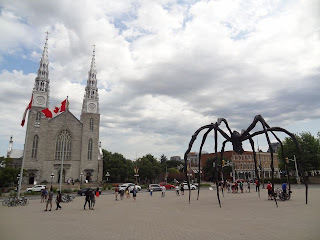 Giantspider sculpture in Ottawa, Canada (© Markus Bühler)
Giantspider sculpture in Ottawa, Canada (© Markus Bühler)
Needless to say, all of the issues ofphysiological improbability that I discussed previously in relation to my soldiercorrespondent's sightings claims apply equally here. Yet as I also noted previously,it is not inconceivable, surely, that some novel evolutionary advancement of thetypical size-limiting spider respiratory system could yield spiders bigger thanthose presently known to science (though as there is currently no physical evidenceof any kind to substantiate this, such a notion is presently wholly speculative).
Meanwhile, I'll be very interested to seewhether this long-awaited, long-hoped-for first independent testimony to the putativereality of Fort Polk's reputed mega-spiders induces other reports of such creaturesfrom this Louisiana location to emerge.
My thanks once again to Rich Janusz for sokindly permitting me to document his extremely interesting, thought-provoking informationhere.
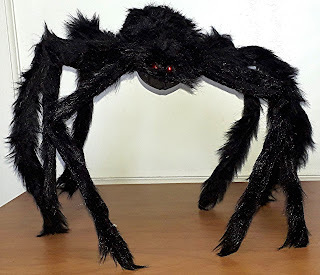 Anotherview of my giant spider model (© Dr Karl Shuker)
Anotherview of my giant spider model (© Dr Karl Shuker)
September 28, 2023
THE TULLY MONSTER, THE LOCH NESS MONSTER, AND TURKANA'S DANCING WORMS
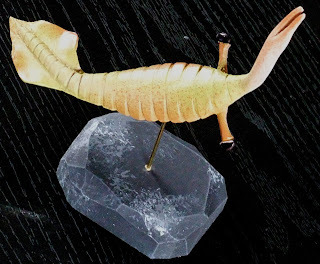 Tullimonstrum gregarium
– my Tully Monster model, seen from below (© Dr Karl Shuker)
Tullimonstrum gregarium
– my Tully Monster model, seen from below (© Dr Karl Shuker)Down through the decades since it firstattracted notable public and media attention during the early 1930s, Scotland's(in)famous Loch Ness Monster has inspired all manner of suggestions as to itspossible zoological identity – always assuming, of course, that it actuallyexists in the first place!
But none, surely, can be any strangerthan the little-known example revealed here, a veritable monster in its ownright – and which also featured at much the same time, moreover, in one of themost extraordinary zoological hoaxes ever recorded, concerning a large and highlydangerous yet hitherto inexplicably-overlooked species of dancing worm!
MEETING TULLY'SMINI-MONSTER
In July 1966, based upon some fossils foundin Illinois and dating back 280-300 million years, Dr Eugene S. Richardson Jr(1916-1983), Curator of Fossil Invertebrates from Chicago's Field Museum ofNatural History, fully described within that month's issue of the FieldMuseum's scientific Bulletin a newspecies of small, ostensibly inauspicious worm-like creature, but which has subsequentlyproved to be one of the most zoologically baffling beasts ever recorded byscience. Not only that, it can also boast a couple of startling, unexpectedlinks to cryptozoology, as will now be seen.
The official taxonomic name of thisenigmatic little animal is Tullimonstrumgregarium, which Richardson had bestowed upon it a short time previously inthe prestigious American weekly journal Science.However, it is commonly known colloquially simply as the Tully Monster, and insubsequent years it became so famous that in 1989 it was officially designatedthe State fossil of Illinois.
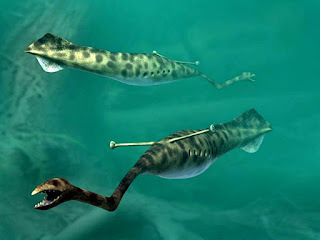 Tullimonstrum
representations in life (© Nabu Tamura/Wikipedia –
CC BY-SA 4.0 licence
)
Tullimonstrum
representations in life (© Nabu Tamura/Wikipedia –
CC BY-SA 4.0 licence
)
This very strange species derives bothits binomial and its vernacular name from its fossils' discoverer, Francis J. Tully,an amateur fossil collector who in 1958 had found some specimens of it in theMazon Creek formation, a series of fossil beds in Grundy County, northeastern Illinois,which had been a coastal estuary during the Late Carboniferous Period when Tullimonstrum had thrived. Unable toidentify them, Tully took these mystifying specimens to the Field Museum, whosepalaeontologists were equally puzzled, never having seen anything like thembefore.
However, further fossils of this archaicmystery mini-beast were subsequently discovered – so many, in fact, that theirabundance inspired Richardson's eventual naming of it, because Tullimonstrum gregarium translates as'common Tully monster'. Having said that, however, only one Tully Monster speciesis known, and only one very specific locality for it is known (the Essex biotasection of the Mazon Creek fossil beds) – but what is not known at all, or atleast not for certain, is what on earth, or in earth, Tullimonstrum actually is!
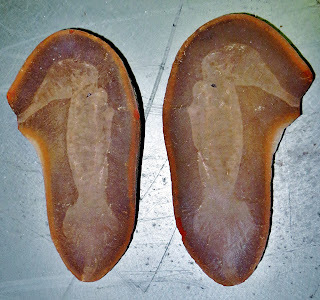 Tullimonstrum
fossils (© Ghedoghedo/Wikipedia –
CC BY-SA 3.0 licence
)
Tullimonstrum
fossils (© Ghedoghedo/Wikipedia –
CC BY-SA 3.0 licence
)
The reason why this ancient anomaly is sobaffling is its morphology, which is so thoroughly bizarre that it has defiedall attempts by researchers to categorise with any degree of satisfaction orconfidence its singular species within any pre-existing taxon, not even one aselevated in the taxonomic hierarchy as a phylum.
Vermiform in basic body shape andmeasuring approximately 3-14 inches long, Tullimonstrumis characterized by some truly novel attributes. At its anterior end is a longslender proboscis terminating in a grasping, claw-like pair of jaws, eachcontaining up to eight small, sharp tooth-like structures. Just behind the baseof the proboscis is a thin transverse bar, at either end of which is a smallround organ believed to be a camera-like eye, each containing melanosomes whoseform and structure is consistent with such an identity for it. Further backstill are paired structures that have been identified as gills, and its mostposterior, tail-end body portion bears a pair of vertical fins resembling aspade in shape. In addition, and the principal reason for its having incited somuch speculation as to its taxonomic identity, is the presence of what may be a rudimentary notochord or spinalcord.
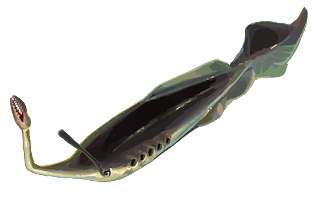 Tullimonstrum reconstructed as a lamprey-like beast (© Entelognathus/Wikipedia–
CC BY-SA 4.0 licence
)
Tullimonstrum reconstructed as a lamprey-like beast (© Entelognathus/Wikipedia–
CC BY-SA 4.0 licence
)Every few years ever since its mid-1960sdescription, a new study of its fossils results in a new idea being proposed inthe scientific literature as to what Tullimonstrummay be, only for this to be hotly disputed by opposing viewpoints.
The most recent published study andproffered opinion dates from as recently as April 2023, when a Japaneseresearch team announced that their advanced 3-D imaging techniques had revealedthat Tullimonstrum has segmentationin its head region which extends from its body – something that no knownvertebrate lineage possesses. So in spite of possessing a putative notochord orspinal cord, Tullimonstrum was not,they believed, of vertebrate affinity.
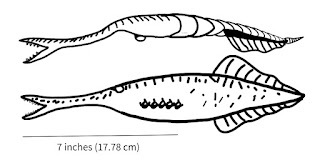 Tullimonstrum
reconstructed as an invertebrate (above), and as a vertebrate (below)(© Fossiladder 13/Wikipedia –
CC BY-SA 4.0 licence
)
Tullimonstrum
reconstructed as an invertebrate (above), and as a vertebrate (below)(© Fossiladder 13/Wikipedia –
CC BY-SA 4.0 licence
)
Previous suggestions by earlierresearchers, meanwhile, have ranged from this latter beastie being a basal vertebratedistantly related to lampreys, or an anomalocaridid-allied arthropod, to aspecialized form of mollusc, a worm, a conodont, or a chordate but ofnon-vertebrate identity (like present-day tunicates).
As this present ShukerNature blog articleis not concerned primarily with either the taxonomic or the palaeontologicalcomplexities and controversies relating to Tullimonstrum,however, I shall abstain from presenting any further considerations of thesesubjects here, and progress instead to what it is concerned with. Namely, two very surprising links betweenTully's weird little worm from the far-distant past and cryptozoology in moderntimes.
IS THE TULLYMONSTER THE LOCH NESS MONSTER?
Ever since the early 1930s, the Loch NessMonster has always been a major source of cryptozoological contention, but thiswas especially true during the 1960s and 1970s, following Tim Dinsdale'sshooting in 1960 of his short but iconic cine-film purportedly showing a verylarge, unidentified creature moving across and below the loch's surface.Numerous Nessie-themed books and articles appeared during this period, but oneof the most unusual was undoubtedly TheGreat Orm of Loch Ness: A Practical Inquiry Into the Nature and Habits ofWater-Monsters, authored by F.W. 'Ted' Holiday (1921-1979) and published in1968.
Holiday had long been intrigued by Nessieand other aquatic mystery beasts, but whereas in a second book, The Dragon and the Disc (1973), hepursued a paranormal explanation for such entities (even linking them to UFOs),in The Great Orm of Loch Ness headopted a more conventional approach, proposing a corporeal, zoologicalidentity for Nessie. However, the specific creature that he nominated wasdecidedly unconventional.
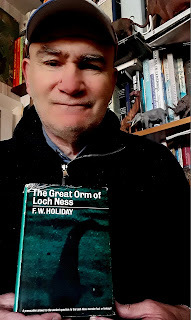 Holdingmy copy of Holiday's book The Great Ormof Loch Ness (© Dr Karl Shuker/Faber & Faber – reproduced here on astrictly non-commercial Fair Use basis for educational/review purposes only)
Holdingmy copy of Holiday's book The Great Ormof Loch Ness (© Dr Karl Shuker/Faber & Faber – reproduced here on astrictly non-commercial Fair Use basis for educational/review purposes only)
Rather than any of the then-in vogueherpetological contenders (such as a giant newt or frog-like amphibian, acrocodilian reptile, or, most popular of all back in those times, a livingmodern-day species of plesiosaur), after receiving a copy of Richardson's 1966paper from a fellow LNM investigator Holiday boldly proposed that the Loch NessMonster was nothing less than a gargantuan present-day descendant of the TullyMonster!
Holiday postulated that Nessie'sfrequently-reported long slender neck was in reality the elongate proboscis ofhis proposed giant Tullimonstrum,that Nessie's front flippers were actually his latter hypothesised creature's transverseappendages, and that Nessie's posterior body region, sometimes likened byeyewitnesses to a finned tail, was in fact the latter's paired vertical tailfins. He also saw indications of two dorsal humps in various photographs andother illustrations of Tullimonstrumfossils that might explain Nessie's famous humps if present in a giant TullyMonster.
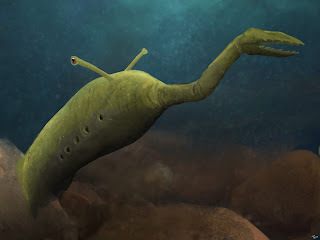 Tullimonstrum
as a lamprey-like beast (© PaleoEquii/Wikipedia –
CC BY-SA 4.0 licence
)
Tullimonstrum
as a lamprey-like beast (© PaleoEquii/Wikipedia –
CC BY-SA 4.0 licence
)
Speaking of which, he pondered whetherthe small specimens of this extraordinary fossil creature so far discoveredwere only immature examples, and that perhaps there were full-sized (i.e.Nessie-sized) specimens still awaiting scientific discovery:
Moreover, it isby no means impossible that sections or parts of much larger Tully monsters mayeven now be reposing in museum basements awaiting identification.
Fifty-five years have passed sinceHoliday wrote those optimistic words, but as yet, however, no such specimenshave come to light. Nor is that the only major issue with Holiday's attempts toidentify the Loch Ness Monster with the Tully Monster. The sad but simple truthis that he had misunderstood the true nature of certain key aspects of the latter'smorphology, which inevitably had led his proposals badly astray.
 LochNess (public domain)
LochNess (public domain)
For instance, in his book he referred tothe most anterior jawed portion of Tullimonstrumas its head, whereas in reality it is nothing more than the terminal jaws of thiscreature's long proboscis – and which Holiday misrepresented as its neck.Similarly, he did his best to identify the transverse bar behind the base ofthe proboscis as a pair of locomotory paddles, when in reality the pair of fleshylobes at the two ends of this bar are believed to be visual organs, becausethey appear to contain some form of retinal structure. And what he envisaged ashumps along its back appear to be nothing more than artifacts caused by theflattening of the fragile Tullimonstrum specimensduring their fossilization.
Of course, one might suggest in Holiday'sdefence that by not being a zoologist or palaeontologist he could be forgivenfor drawing such erroneous conclusions. Unfortunately, however, this defencefalls by the wayside when we discover that his book also includes as anappendix the full text of Richardson's July 1966 Bulletin paper describing Tullimonstrum,in which its body regions' anatomy and functions are accurately documented byRichardson. In addition, Holiday had even corresponded directly with Richardsonregarding his proposal that Nessie was a giant Tully Monster (but regardingwhich Richardson had in turn expressed grave misgivings to him). Consequently,Holiday had no excuse for his own highly inaccurate assumptions regarding thesesame matters.
 Tullimonstrum
, the Tully Monster – but evidently not the Loch Ness Monster (©Tim Morris)
Tullimonstrum
, the Tully Monster – but evidently not the Loch Ness Monster (©Tim Morris)
Holiday had long believed that Nessie wassome form of giant worm – hence the title of his book, the word 'orm' being anarchaic version of 'worm'. This latter term is in turn sometimes applied notmerely in zoology to limbless elongate invertebrates of the earthworm andoutwardly similar kind, but also in western mythology to dragons that fit thatsame description, i.e. elongate and limbless, such as the famous Lambton wormand Laidly worm. This therefore explains why his second book, linking Nessie toUFOs, was entitled The Dragon and theDisc.
Holiday also considered the Tully Monsterto be a worm, but one of a uniquely plesiosaurian shape:
Tully's monsterdid one great thing. It firmly demonstrated that wormlike animals with theappearance of a plesiosaurus did once exist.
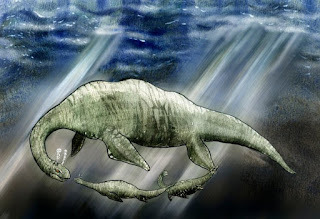 Typicalplesiosaurian representation of Loch Ness Monster (© Richard Svensson)
Typicalplesiosaurian representation of Loch Ness Monster (© Richard Svensson)
If so, this could explain not onlyNessie's shape when seen by eyewitnesses but also why it wasn't seen more often,i.e. on a regular basis. For if Nessie were indeed a worm, it could therefore absorboxygen from the loch's water directly through its body's outer layer (epidermalrespiration, like frogs and salamanders can often do), not needing to surfaceon a frequent basis in order to inhale air into its lungs like a mammal orreptile would need to do. Accordingly, Holiday concluded his personalidentification of Nessie as a giant undiscovered modern-day Tully Monster withthe following bold statement:
No-one knows whetherthe Orm of Loch Ness is a form of Tullimonstrum;but, talking most unscientifically, I would bet my shirt that it is.
Sadly, however, I think that my aboveaccount of how and why his understanding of Tullimonstrumis seriously flawed, and, as an inevitable consequence, his conclusion that agiant version of this species does indeed explain Nessie is wholly wayward,proffers more than sufficient evidence to suggest that Holiday would havecertainly lost his shirt!
THE DANCINGWORMS OF TURKANA
At much the same time that Holiday wasseeking with fervor but ultimate futility to link the Tully Monster to the LochNess Monster, Tullimonstrum was alsohitting the cryptozoological headlines for a very different yet no lessmemorable reason.
On 1 September 1966, after reading areport in the East African Standard(a very well known newspaper in what was then British East Africa) concerningthe discovery and Richardson's recent scientific description of Tullimonstrum, a retired armyLieutenant-Colonel named R.G.L. Cloudesley, from Nairobi in Kenya, wrote anextraordinary letter to Richardson, in which he made the following potentiallyexciting claim. The relevant portion reads as follows:
In 1926 having been seconded to the Kings (now Kenya) AfricanRifles from the Indian Army, I was in northwestern Kenya dealing with someborder incidents. Passing through the administrative centre of Lodwar on my return journey,I took the opportunity of calling upon Mr. A. M.Champion, then D. C. Turkana District. In addition to being a keen shikar,Champion was a naturalist of the first rank, and during the two evenings Ipassed in his company he regaled me with many a fascinating yarn about thefauna of the area. Among these was one about a remarkable worm reputed to livein the swamp country to the southeast. The local tribesmen told fantasticstories about its dancing and giving milk, if I remember correctly. Suchnonsense aside, Champion did give me a description of the creature which hehad obtained from various natives (he never succeeded in getting a specimen)and this curiously enough has remained in my memory when much else has beenforgotten. His account agreed remarkably well with the illustration of your"Tully Monster," even to the "paddles" and the long snout.Your mention of sharp teeth, incidentally, does agree with a Turkana tale thatthe creature bites. On this account they are deathly afraid of it, believingthat it is poisonous. But then nearly all natives believe everything of thecreeping or crawling kind to be venomous.
I hardly dare to suggest that a relation of your extinct"Monster" still survives in one of the remotest parts of East Africa,but it might just be worthwhile to pursue the matter.
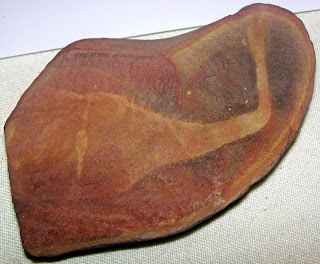 Tullimonstrum fossil (© James St John/Wikipedia –
CC BY 2.0 licence
)
Tullimonstrum fossil (© James St John/Wikipedia –
CC BY 2.0 licence
)Turkana is a northwestern county inKenya, famous for the discovery there of various significant fossil hominidremains.
Unsurprisingly, Richardson was veryinterested in Cloudesley's letter, but even before he had chance to reply to ithe received a second letter of note, dated 13 September 1966, this time fromPurshottan S. Patel of Nakuru, a town situated about 100 miles northwest ofNairobi. Patel informed Richardson that something like Tullimonstrum may actually be existing in Turkana's lakes, as he'dbeen told by relatives of a strange form of dancing worm that lived in thesewatery expanses.
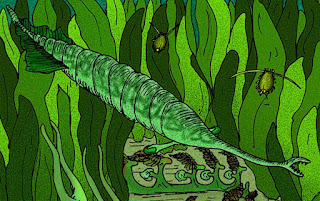 Thelong-extinct Tullimonstrum gregarium –but was there a living Tully Monster species of terpsichorean tendency awaitingscientific discovery in the lakes of Turkana? (© Stanton F. Fink/Wikipedia –
CC BY-SA 2.5 licence
)
Thelong-extinct Tullimonstrum gregarium –but was there a living Tully Monster species of terpsichorean tendency awaitingscientific discovery in the lakes of Turkana? (© Stanton F. Fink/Wikipedia –
CC BY-SA 2.5 licence
)
Not long afterwards, Richardson receiveda third letter, dated 8 September 1966, from Joseph N. Ngomo, an intermediateschool teacher from Nakuru, who informed him that after his class had read the Standard newspaper's report concerning Tullimonstrum, several of his pupils hadclaimed that they'd been told of a similar-sounding creature from theirfathers. Ngomo included in his letter a note written by one such pupil, a boynamed Akai, which stated that these worms are known locally as the ekurut loedonkakini,swim and "wave hands" during the full moon, give milk, and possess abite fatal to humans.
By now, Richardson was sufficientlyintrigued by these ostensibly independent yet closely corroboratingcommunications to suggest to his colleagues at the Field Museum that anexpedition in search of Turkana's tantalising dancing worms might be justified,because if they did turn out to be a living Tullimonstrumspecies this would obviously be a very momentous zoological discovery. First ofall, however, a note requesting any additional information regarding thesecreatures was prepared by the Museum and duly published in the Newsletter of the East African NaturalHistory Association – but none was forthcoming.
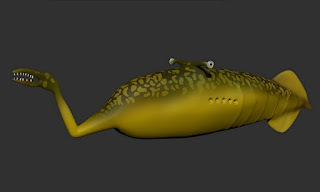 3Dmodel of Tullimonstrum gregarium as avertebrate (© Петр Меньшиков-Wikipedia –
CC BY-SA 4.0 licence
)
3Dmodel of Tullimonstrum gregarium as avertebrate (© Петр Меньшиков-Wikipedia –
CC BY-SA 4.0 licence
)
In early 1967, while the proposed expeditionwas still at the planning stage, Richardson was visited by a former colleague,palaeontologist Dr Bryan Patterson (1909-1979), now a professor at HarvardUniversity but previously Curator of Vertebrate Palaeontology at the ChicagoField Museum. Patterson had recently conducted some field work in Kenya andstated that he actually knew the uncle of Richardson's second correspondent,Patel. However, Patterson also stated that he'd never heard of dancing worms atTurkana, and seemed highly amused by the whole subject – as well he might be.
For it subsequently transpired thatCloudesley, Patel, Ngomo, and Akai did not exist – they had all been created,and their communications written, by none other than Patterson himself, as aprank with which to fool his friend Richardson, and which had clearly succeededvery successfully!
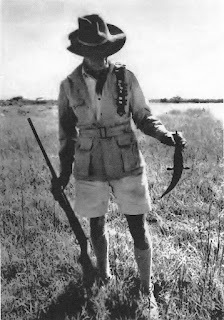 Fakephotograph of Dr Bryan Patterson and a shot Tullimonstrum(public domain)
Fakephotograph of Dr Bryan Patterson and a shot Tullimonstrum(public domain)
Happily, Richardson took it all in goodspirit after receiving the truth from Patterson in a Christmas 1968 letter thatalso included a humorous hoax photograph in which Patterson was posing in fullfield regalia holding a rifle and a supposed shot specimen of a sizeable Tullimonstrum. Indeed, after cancellinghis planned expedition to search for it, Richardson even prepared a short bookentitled The Dancing Worm of Turkana,publishing it in 1969 under the pseudonym E. Scumas Rory. In it, he reproducedall four of the principal fake communications sent to him by Patterson, andalso briefly referred to a second missive that he'd received from 'Patel', plusseveral additional ones sent to him by various other correspondents.
Additionally, Richardson revealed in thisbook that F.W. Holiday had written to 'Cloudesley' for information, but hadnever received a reply (for obvious reasons now!). Moreover, Richardson evencontributed an introduction to the book under his own name, together with somefine illustrations under his Rory pseudonym, and nowadays this literarycuriosity is a highly-collectable publication in its original hard-copy format(several websites contain downloadable public-domain pdf versions of it).
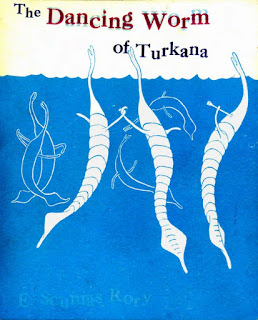 The Dancing Worm of Turkana
, front cover (public domain)
The Dancing Worm of Turkana
, front cover (public domain)
In short, even though the dancing wormsof Turkana never existed, they are immortalized in print, meaning that theirimpact, albeit transitory, upon the zoological world will also live on!
Finally: the name 'E. Scumas Rory' seemsso unlikely, even contrived, that I cannot help but wonder whether in realityit is a clever anagram, but I've been unable to discover one from it. So if anyanagram aficionados are reading this article, perhaps they would like to seewhether they can extract one – and, if anyone does, I'd greatly welcomedetails!
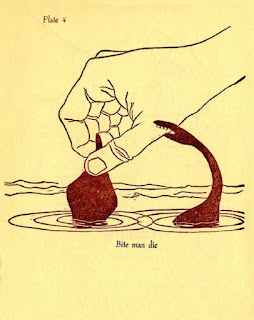 Anekurut loedonkakini or Turkana dancing worm, biting a man – sketch by 'E,Scumas Rory' (public domain)
Anekurut loedonkakini or Turkana dancing worm, biting a man – sketch by 'E,Scumas Rory' (public domain)
July 31, 2023
A CENTENARY CELEBRATION FOR THE INACCESSIBLE ISLAND RAIL - A FLIGHTLESS MINI-BIRD FROM ATLANTIS!
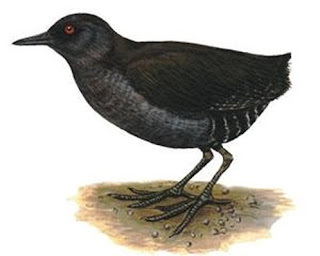 Illustration of the Inaccessible Island rail (public domain)
Illustration of the Inaccessible Island rail (public domain)A hundred years ago this very same month, one of the most diminutive but delightful of all living birds was formally added to the zoological catalogue of recognised species. So here, as a centenary celebration of this remarkable little creature's official unveiling, is a concise history of its discovery.
Inaccessible Island is a tiny islet of the Tristan da Cunha group, sited in the south Atlantic roughly midway between southern Argentina and South Africa, and would have little claim to fame, were it not for a very peculiar member of its avifauna. The species in question is a miniscule rail, only 5 in long (little larger than a newly-hatched chicken), and with such tiny, poorly-formed wings that it is totally flightless, making it the world’s smallest extant species of flightless bird.
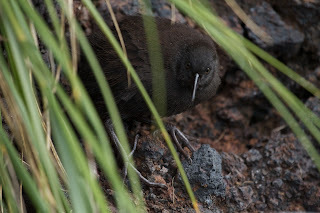 Remaining elusive among its island's abundant tussock grass (© Brian Gratwicke/Wikipedia –
CC BY 2.0 licence
)Its habit of scampering swiftly through the island's wide expanses of dense tussock grass thus makes it seem to the casual observer more akin to a mouse than to a bird. This illusion is enhanced by its strange feathers, which are decomposed (i.e. atrophied) and hair-like. Its upperparts are reddish-brown, its underparts are dark grey, and its belly, flanks, and wing-covert feathers bear paler bands.
Remaining elusive among its island's abundant tussock grass (© Brian Gratwicke/Wikipedia –
CC BY 2.0 licence
)Its habit of scampering swiftly through the island's wide expanses of dense tussock grass thus makes it seem to the casual observer more akin to a mouse than to a bird. This illusion is enhanced by its strange feathers, which are decomposed (i.e. atrophied) and hair-like. Its upperparts are reddish-brown, its underparts are dark grey, and its belly, flanks, and wing-covert feathers bear paler bands. A remote spot, not readily reached, Inaccessible Island was well-named. Due to its inaccessibility, its minute rail (found nowhere else in the world) escaped formal scientific recognition until 1923, when the Reverend H.M.C. Rogers, resident chaplain on Tristan da Cunha, collected some skins of it in response to a request made by the Shackleton-Rowett Expedition's naturalist, a Mr Wilkins. The expedition had visited the island group a little earlier, and had heard the locals speak about the tiny 'island hen' of Inaccessible, but had been unable to travel there to seek it out.
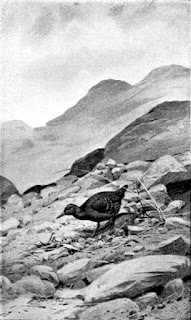 Portrayed in Rose Annie Rogers's book The Lonely Island, published in 1927 (public domain)Nor was that the first scientific expedition to have learned about this mysterious mini-bird without succeeding in procuring a specimen to confirm its reality. In 1905, Lord Crawford had sailed to its island homeland aboard his yacht Valhalla with the express purpose of collecting a specimen after learning of its existence there, but he failed to accomplish his goal. Earlier still, in October 1873, the famous Challenger Expedition of 1872-1876 had visited Inaccessible Island, where its chief scientist, Sir Charles Wyville Thomson, learned of its diminutive denizen and recorded observations that had been made here by two German brothers, the Stoltenhoffs, while residing there during the past two years, but he was unable to obtain a specimen. (Consequently, this elusive bird was actually a cryptid during that 50-year time span, from 1873 to 1923 – known to the locals but officially unconfirmed by science.)
Portrayed in Rose Annie Rogers's book The Lonely Island, published in 1927 (public domain)Nor was that the first scientific expedition to have learned about this mysterious mini-bird without succeeding in procuring a specimen to confirm its reality. In 1905, Lord Crawford had sailed to its island homeland aboard his yacht Valhalla with the express purpose of collecting a specimen after learning of its existence there, but he failed to accomplish his goal. Earlier still, in October 1873, the famous Challenger Expedition of 1872-1876 had visited Inaccessible Island, where its chief scientist, Sir Charles Wyville Thomson, learned of its diminutive denizen and recorded observations that had been made here by two German brothers, the Stoltenhoffs, while residing there during the past two years, but he was unable to obtain a specimen. (Consequently, this elusive bird was actually a cryptid during that 50-year time span, from 1873 to 1923 – known to the locals but officially unconfirmed by science.) Happily, however, these unsuccessful attempts no longer mattered when, on 5 July 1923, two of the skins collected by Rogers arrived at what was then the British Museum (Natural History), and were described that same year by Percy R. Lowe, who named the new species Atlantisia rogersi. 'Atlantisia' alludes to the belief by some workers that the Tristan da Cunha islands are remnants of the fabled sunken continent of Atlantis.
 Hand-held, highlighting its tiny size (© Brian Gratwicke/Wikipedia –
CC BY 2.0 licence
)Previously little-studied, during the 1980s A. rogersi was the subject of a detailed field survey by South African researchers Drs M.J. Fraser and W.R.J. Dean, and Dr I.C. Best from Bahrain, published in 1992. More recently, in 2018, a further study proposed that this species should vacate its memorable monotypic genus, Atlantisia, and instead be rehomed within the pre-existing genus Laterallus, hitherto containing 12 species of crake. Consequently, it is now known as Laterallus rogersi, which may be more accurate taxonomically but is much less romantic – give me Rogers's bird from Atlantis any time!
Hand-held, highlighting its tiny size (© Brian Gratwicke/Wikipedia –
CC BY 2.0 licence
)Previously little-studied, during the 1980s A. rogersi was the subject of a detailed field survey by South African researchers Drs M.J. Fraser and W.R.J. Dean, and Dr I.C. Best from Bahrain, published in 1992. More recently, in 2018, a further study proposed that this species should vacate its memorable monotypic genus, Atlantisia, and instead be rehomed within the pre-existing genus Laterallus, hitherto containing 12 species of crake. Consequently, it is now known as Laterallus rogersi, which may be more accurate taxonomically but is much less romantic – give me Rogers's bird from Atlantis any time! This ShukerNature blog article is excerpted and expanded from my book The Encyclopaedia of New and Rediscovered Animals .
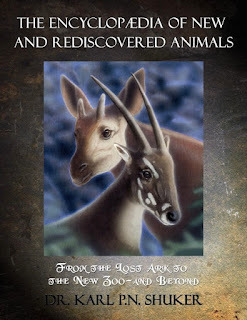
June 30, 2023
HAGGLING OVER THE HAFGUFA
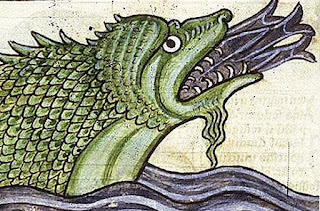 The hafgufa, as depicted in a medieval manuscript, namely the
British Library MS. Harley 3244, fol. 65r, 1236, c.1250,
(public domain)
The hafgufa, as depicted in a medieval manuscript, namely the
British Library MS. Harley 3244, fol. 65r, 1236, c.1250,
(public domain)
The hafgufa is a mysterious sea monster describedin Konungs skuggsjá ('The King's Mirror'), which is a mid-13th-CenturyOld Norse manuscripts – but that is not all. It has actually been traced back asfar as an account in a 2nd-Century-AD text from Alexandria, Egypt, entitledPhysiologus, whose text is accompaniedby illustrations of a whale-like creature termed the aspidochelone, depicted withits huge mouth wide open and fishes jumping into it.
According to The King's Mirror:
It is said of the nature of this fish [the hafgufa] that, whenit goes to feed, it gives a great belch out of its throat, along with whichcomes a great deal of food. All sorts of nearby fish gather, both small andlarge, seeking there to acquire food and good sustenance. But the big fishkeeps its mouth open for a time, no more or less wide than a large sound orfjord, and unknowing and unheeding, the fish rush in in their numbers. And whenits belly and mouth are full, [it] closes its mouth, thus catching and hidinginside it all the prey that had come seeking food”
The hafgufa is also mentioned in various otherNorse manuscripts from this same period. Moreover, a similar description for theaspidochelone is given as follows in Physiologus:
When it is hungry it opens its mouth and exhales a certain kindof good-smelling odor from its mouth, the smell of which, once the smaller fishhave perceived it, they gather themselves in its mouth. But when his mouth isfilled with diverse little fish, he suddenly closes his mouth and swallowsthem.
In the scientific age, there has been muchspeculation and dispute as to whether the hafgufa was based upon a realcreature, and, if so, what that creature might be, with the consensus beingthat it was probably some kraken-like monster.
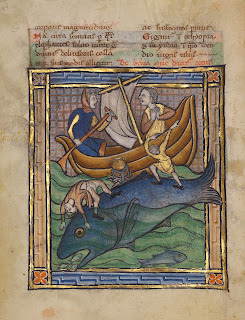 An
a
spidochelonefrom
a Frenchmanuscript, c.
1270
, held at the
J. Paul Getty Museum
(public domain)
An
a
spidochelonefrom
a Frenchmanuscript, c.
1270
, held at the
J. Paul Getty Museum
(public domain)
Now, however, this maritime mystery beast'strue nature may at last have been revealed, thanks to the publicising of a remarkablemode of feeding behaviour practised by various rorqual whales.
Known as trap feeding and firstscientifically recorded in 2010, various humpback whales Megaptera novaeangliae and Bryde's whales Balaeonoptera brydei have been observed waiting motionless at thewater surface in an upright position with their huge mouths wide open, intowhich shoals of fishes unsuspectingly swim to their doom, fatally mistaking thewhales' gaping jaws for shelter, until the jaws close, engulfing them!
Moreover, this eyecatching activity haslately attracted worldwide attention thanks to an Instagram video clip of aBryde's whale performing it that went vital after featuring in a 2021 BBCwildlife documentary (click here to view this clip).
According to the Norse manuscripts, as notedabove, the hafgufa behaves in a similar manner, even actively attracting shoalsof fishes to swim into its open mouth by emitting a specific perfume. And sureenough, when seeking to lure fishes into their mouths by regurgitating food,both the humpback and Bryde's whales produce a distinct smell.
A detailed study examining and comparingmedieval Norse accounts of the hafgufa with modern-day reports of trap feedingby rorquals was published on 28 February 2023 in the journal Marine Mammal Science (click here to read it). The paper was co-authoredby maritime archaeologist John McCarthy, from the College of Humanities, Artsand Social Sciences at Flinders University in Australia, who had becomeinterested in this correlation after reading about the hafgufa in traditionalNorse mythology.
Once again, therefore, it seems likely thatan ostensibly fabulous monster of mythology can lay claim to a firm basis in mainstreamzoological fact after all.
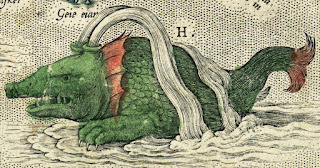 Another illustrationof the hafgufa, this time from Ortelius's 1658 map of Iceland (public domain)
Another illustrationof the hafgufa, this time from Ortelius's 1658 map of Iceland (public domain)
Karl Shuker's Blog
- Karl Shuker's profile
- 45 followers



